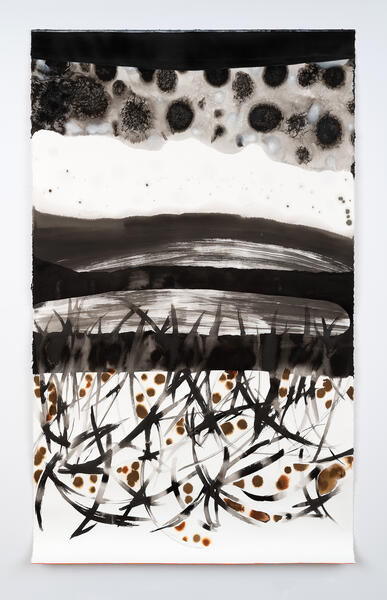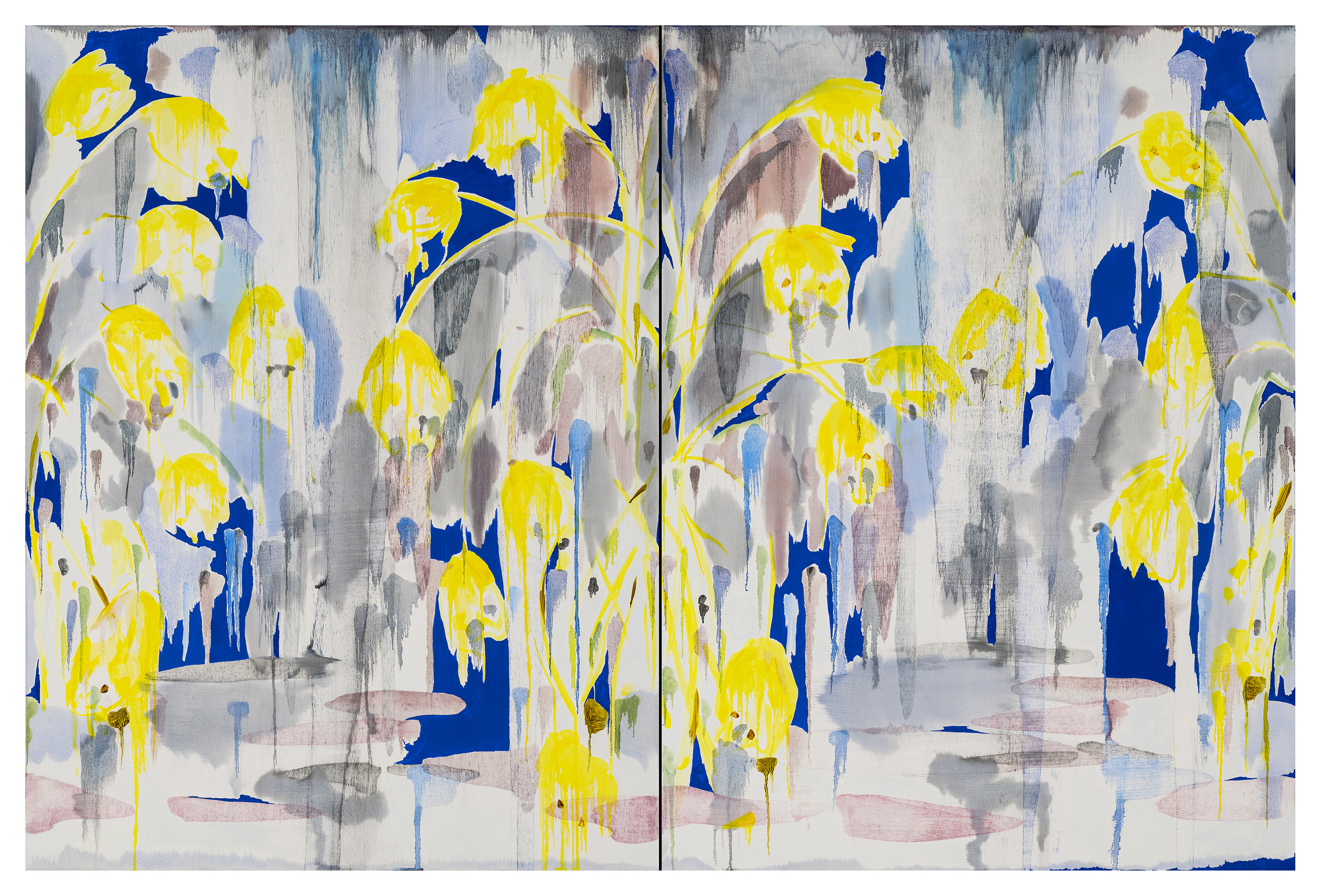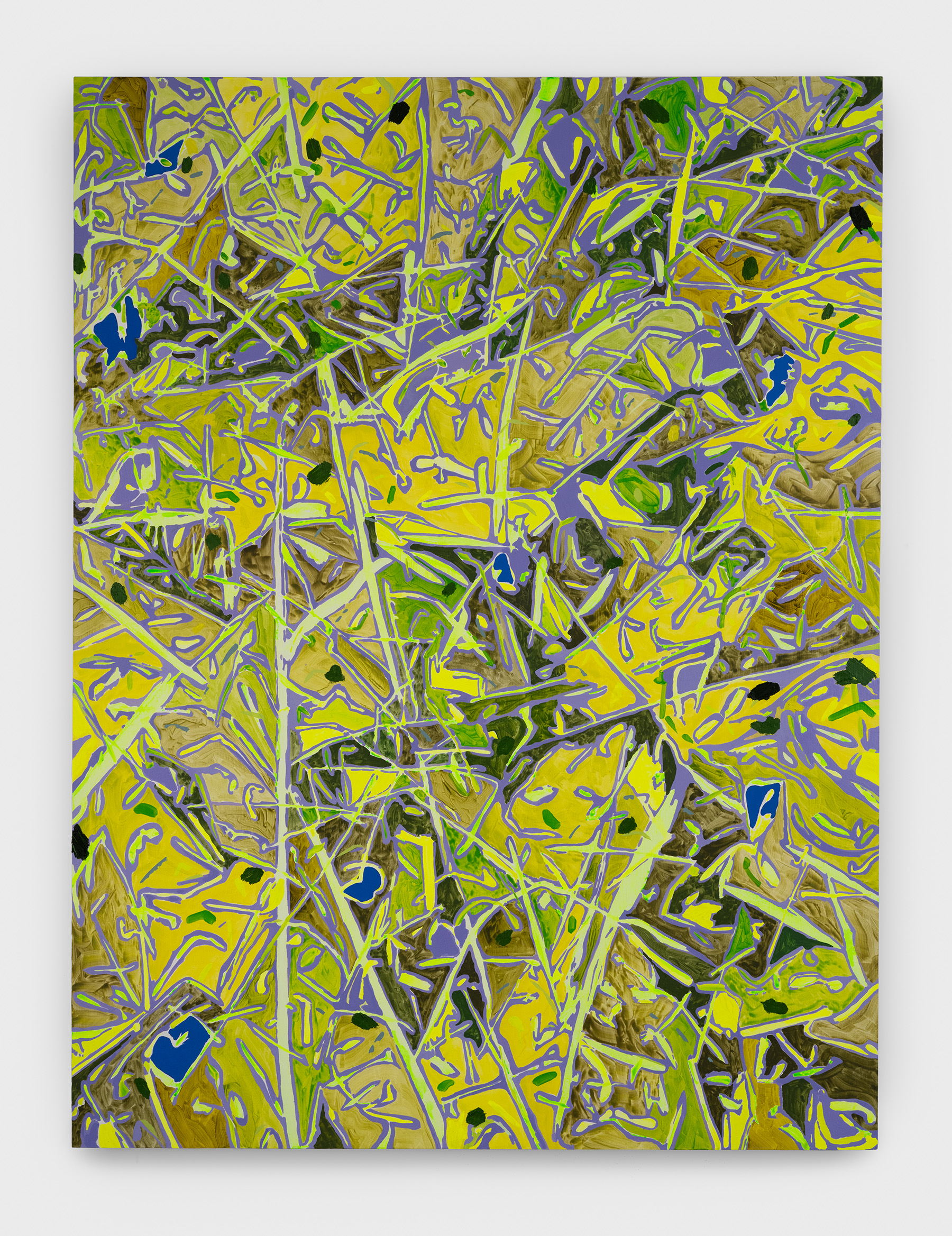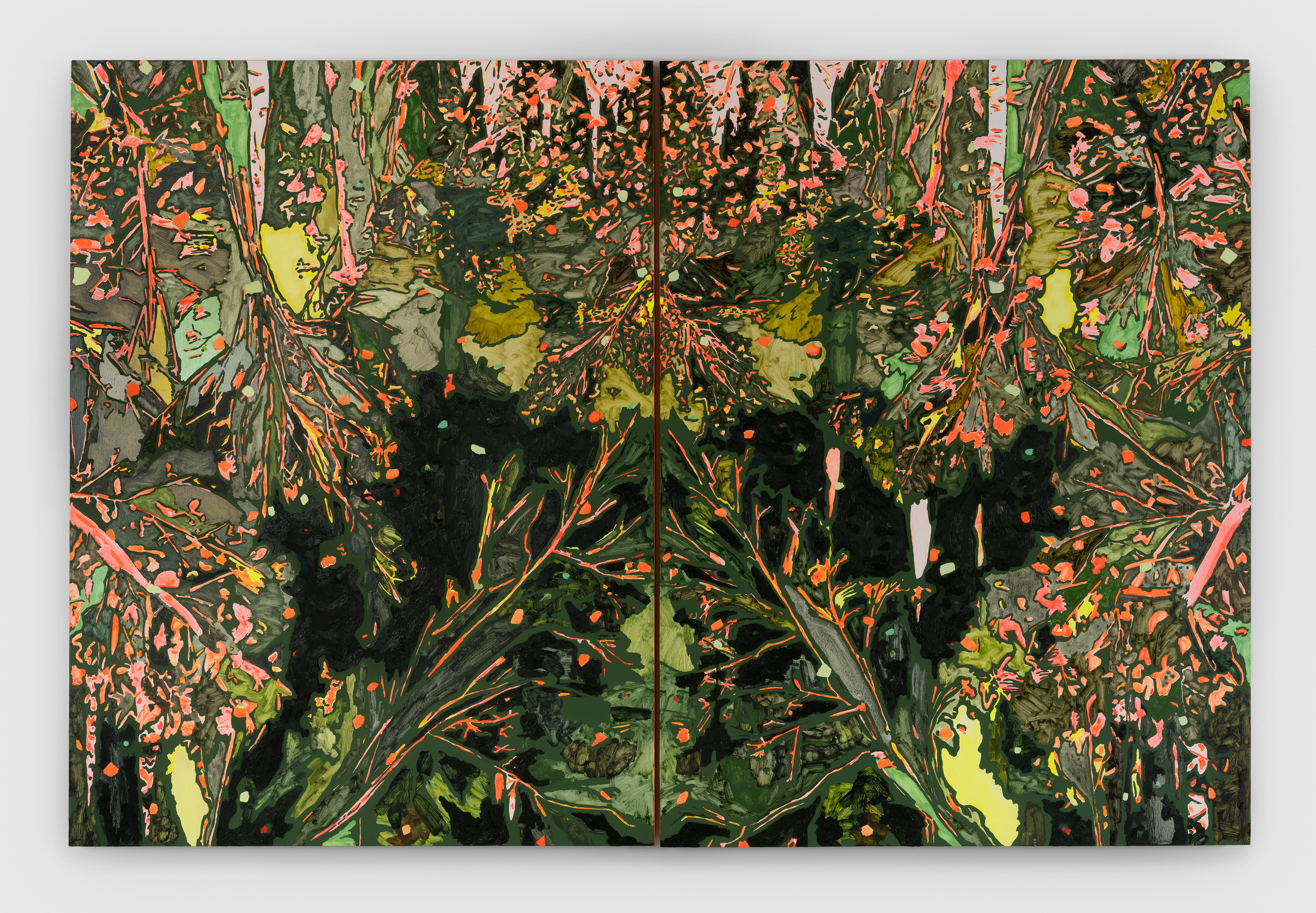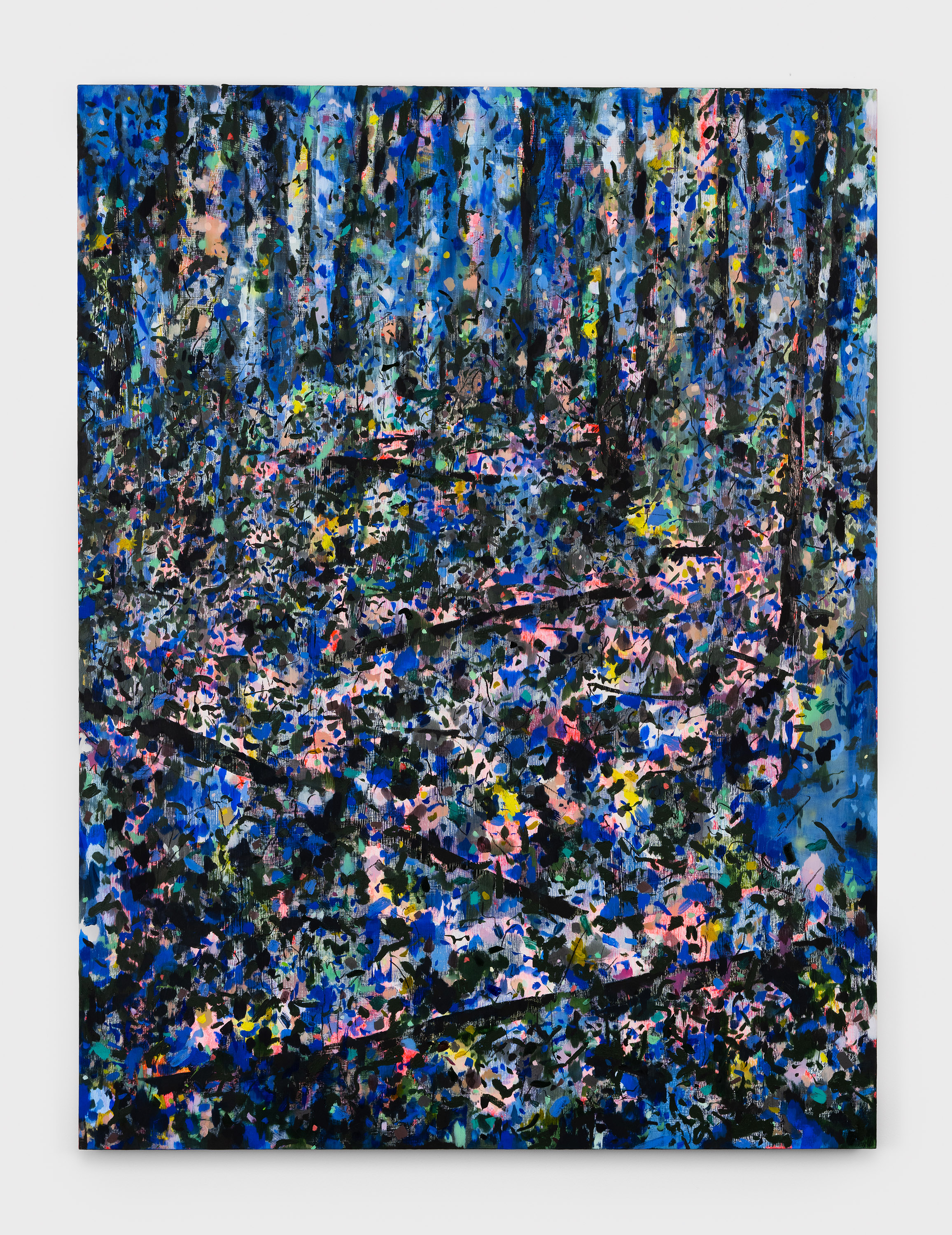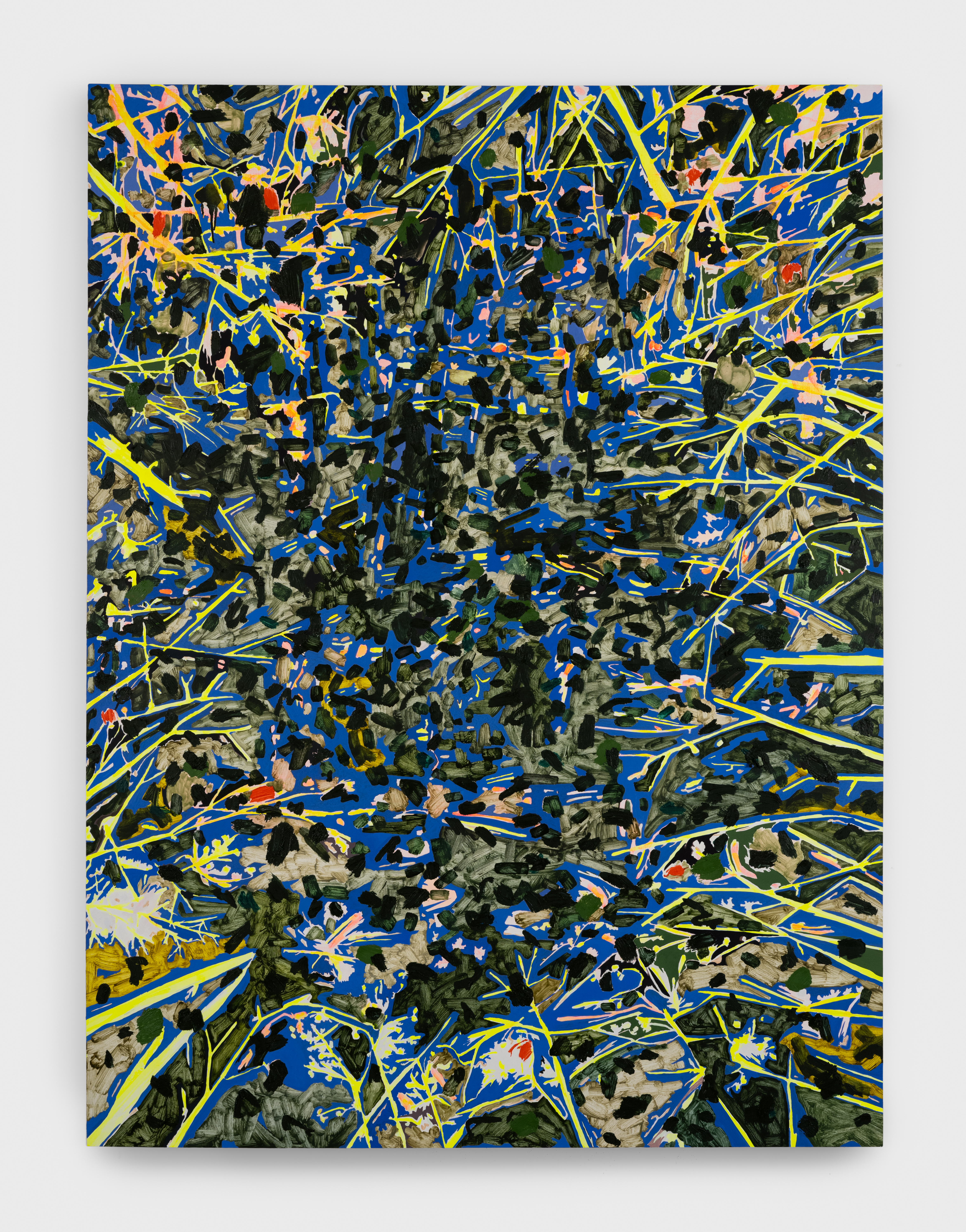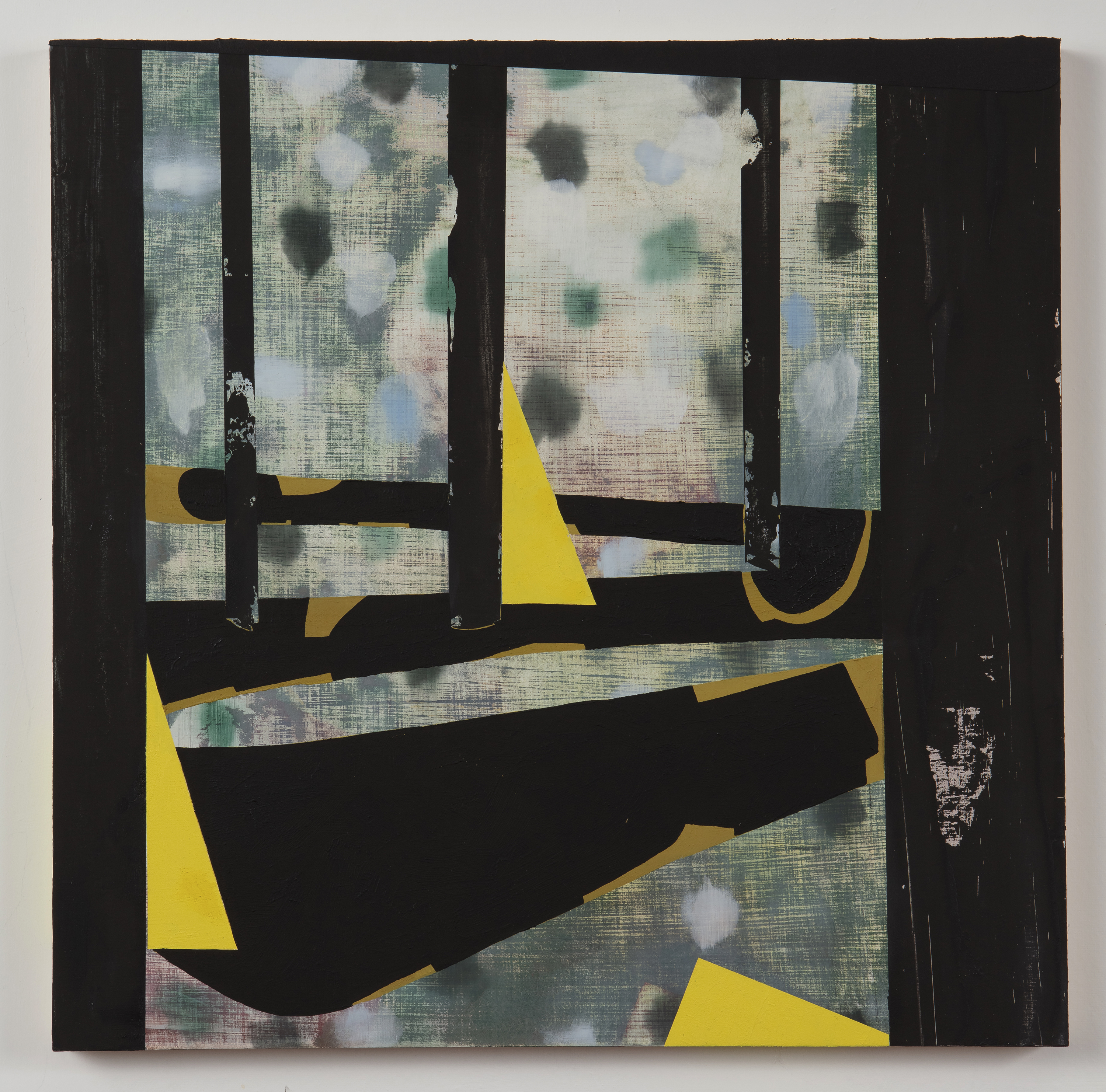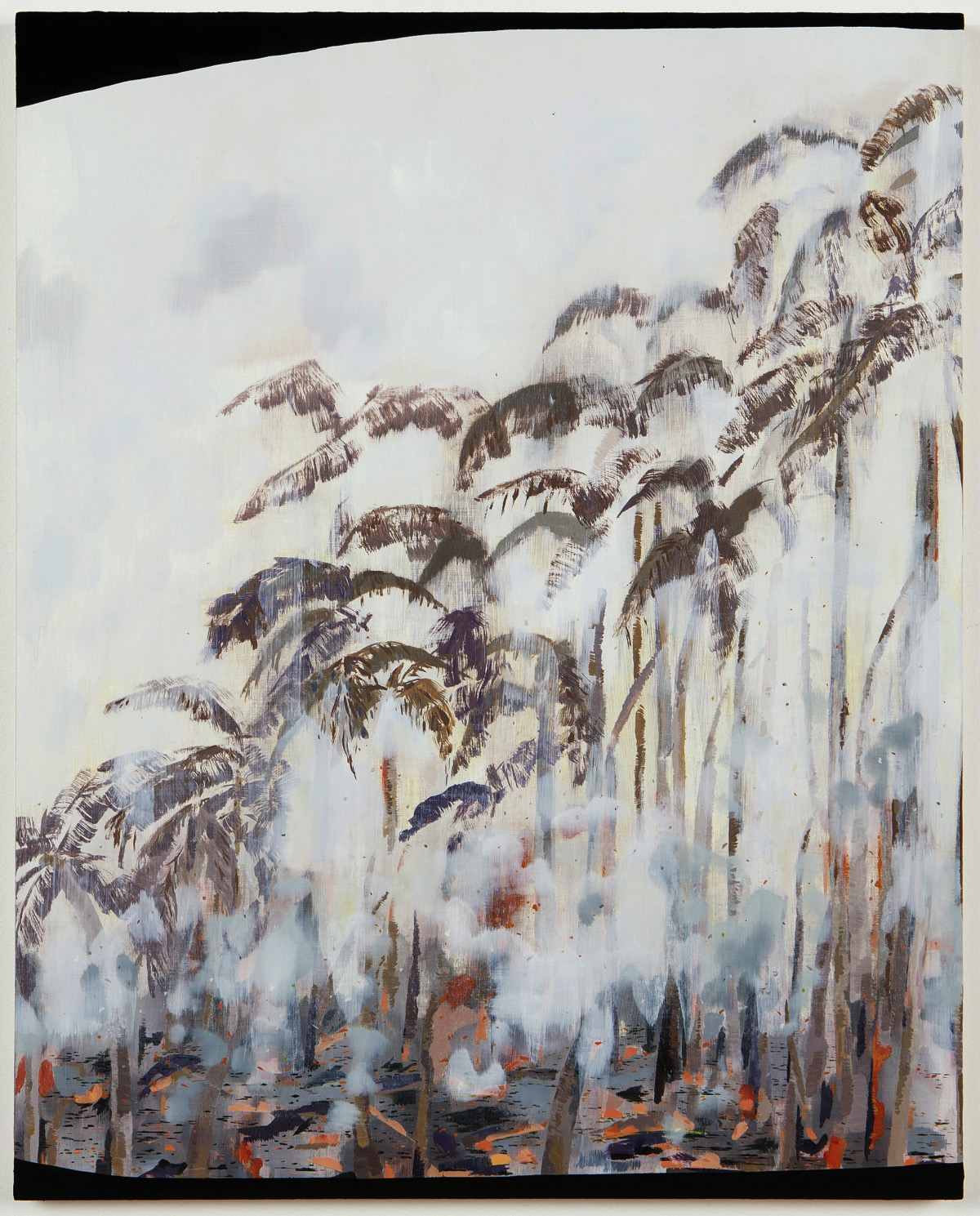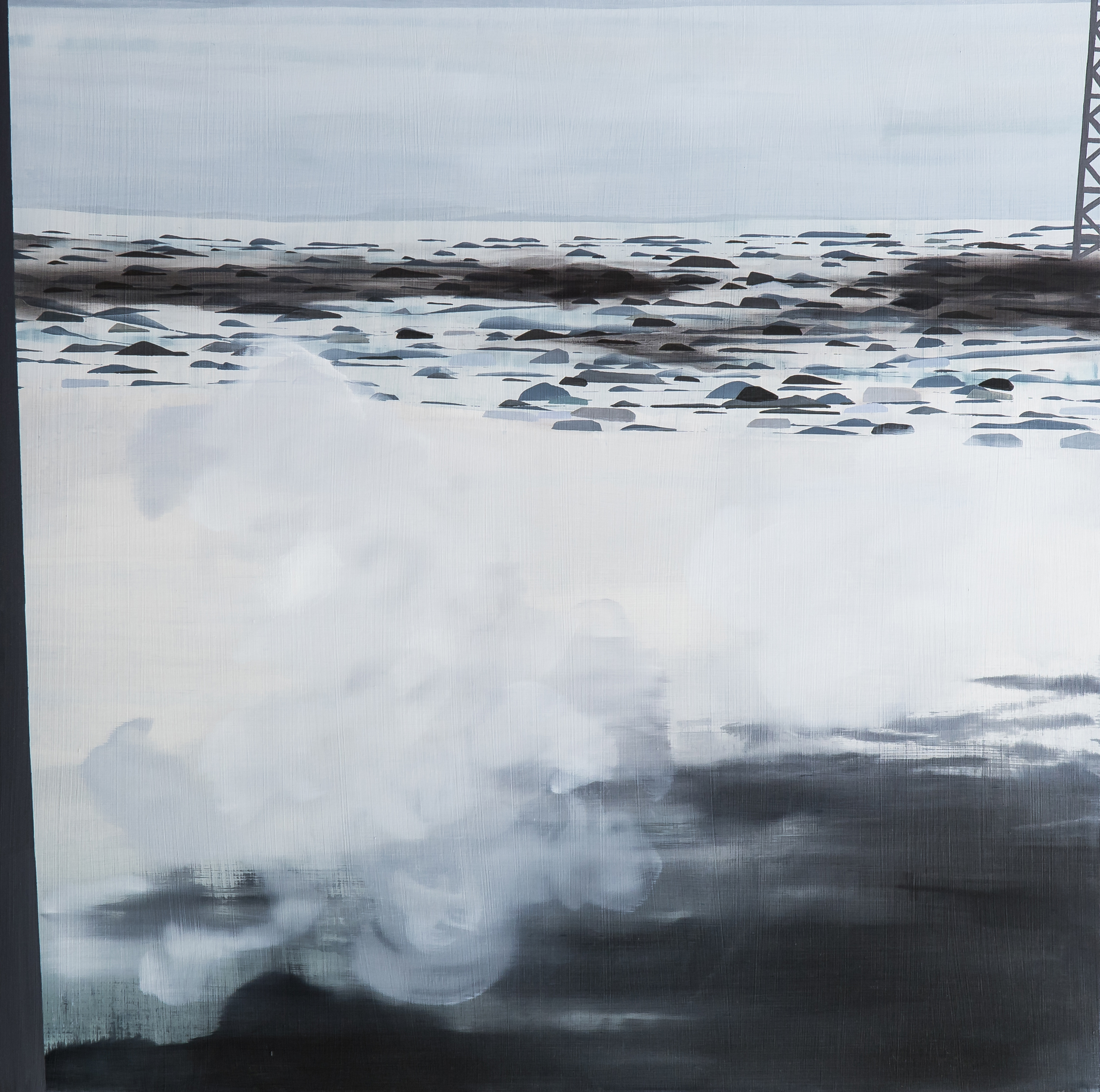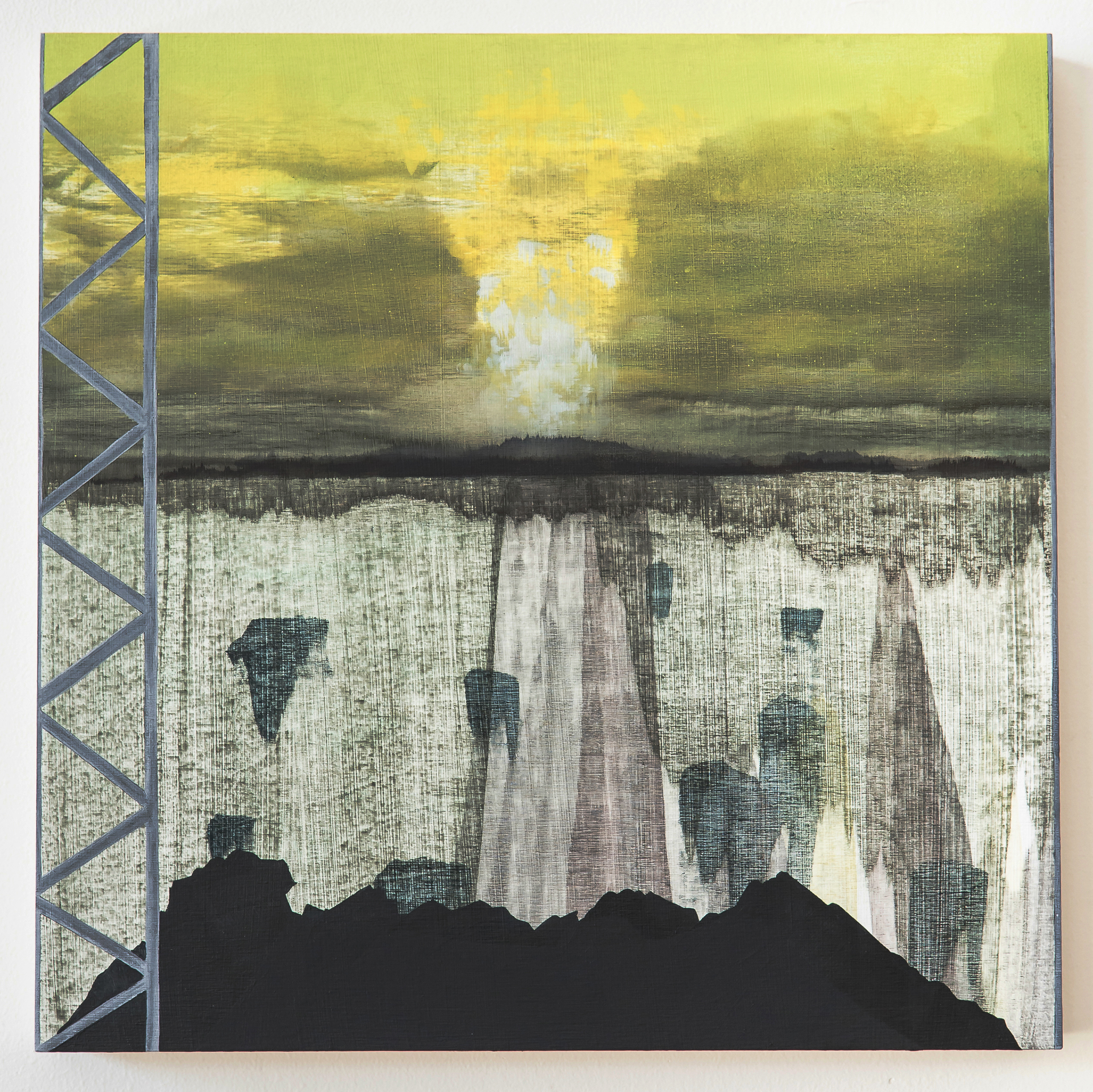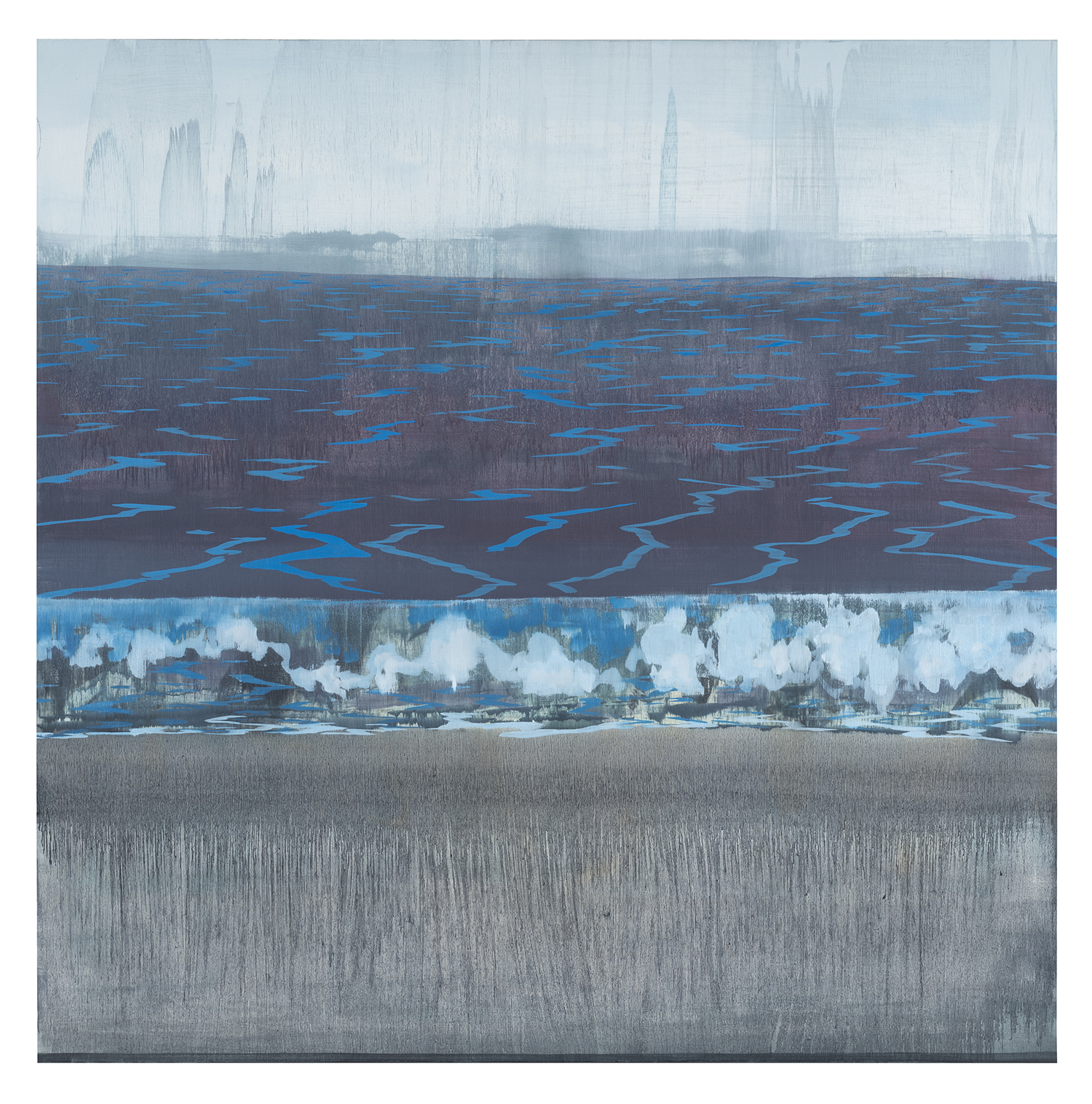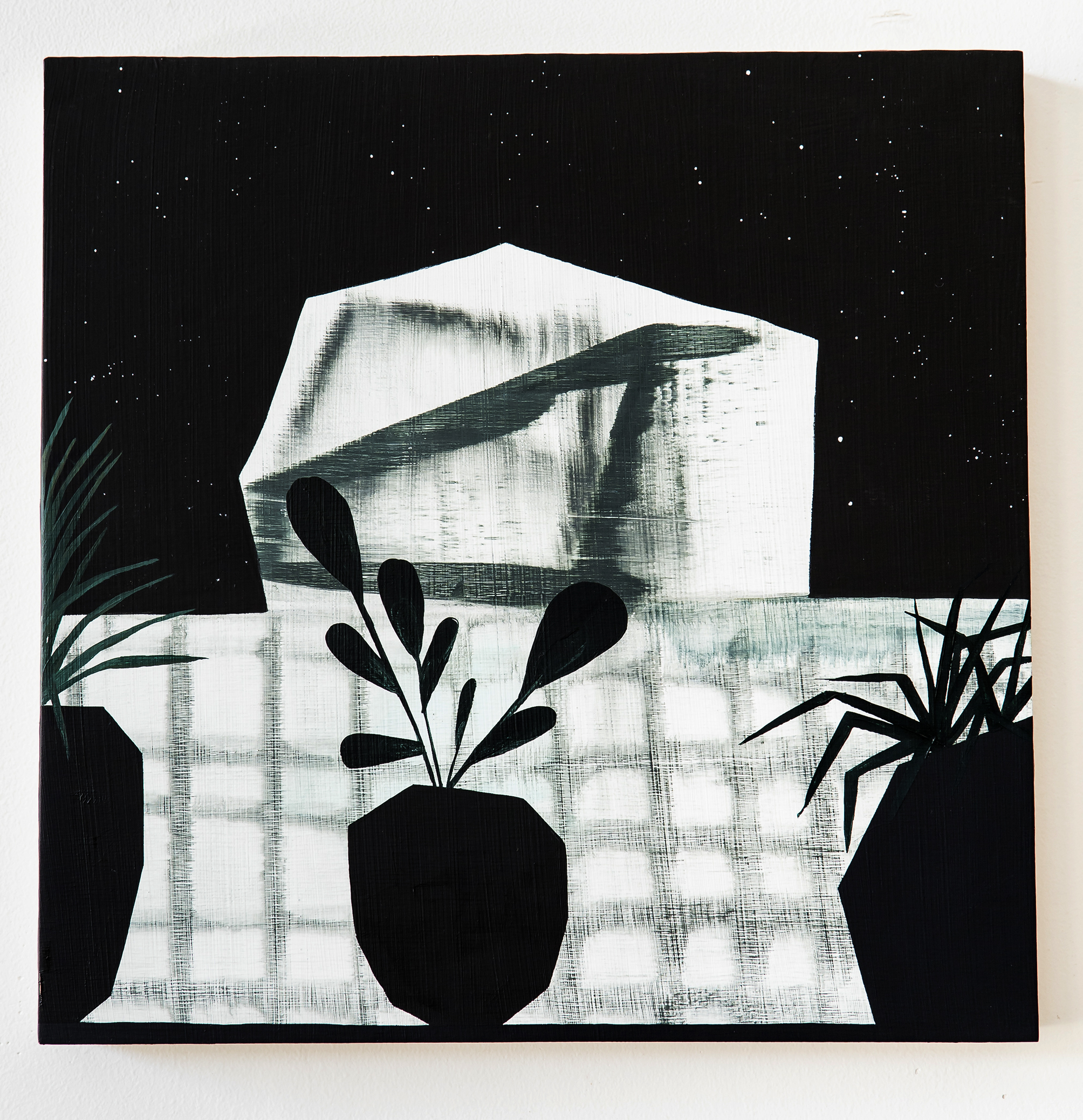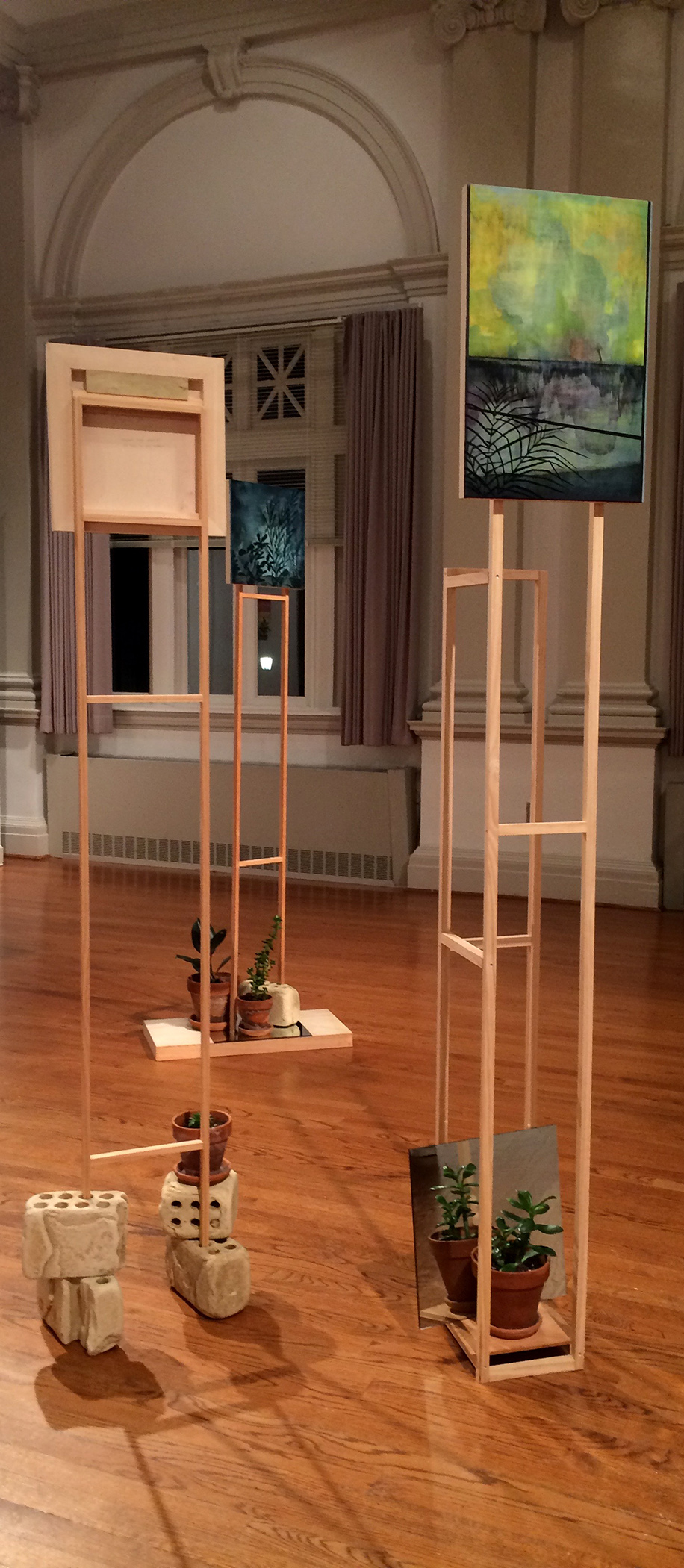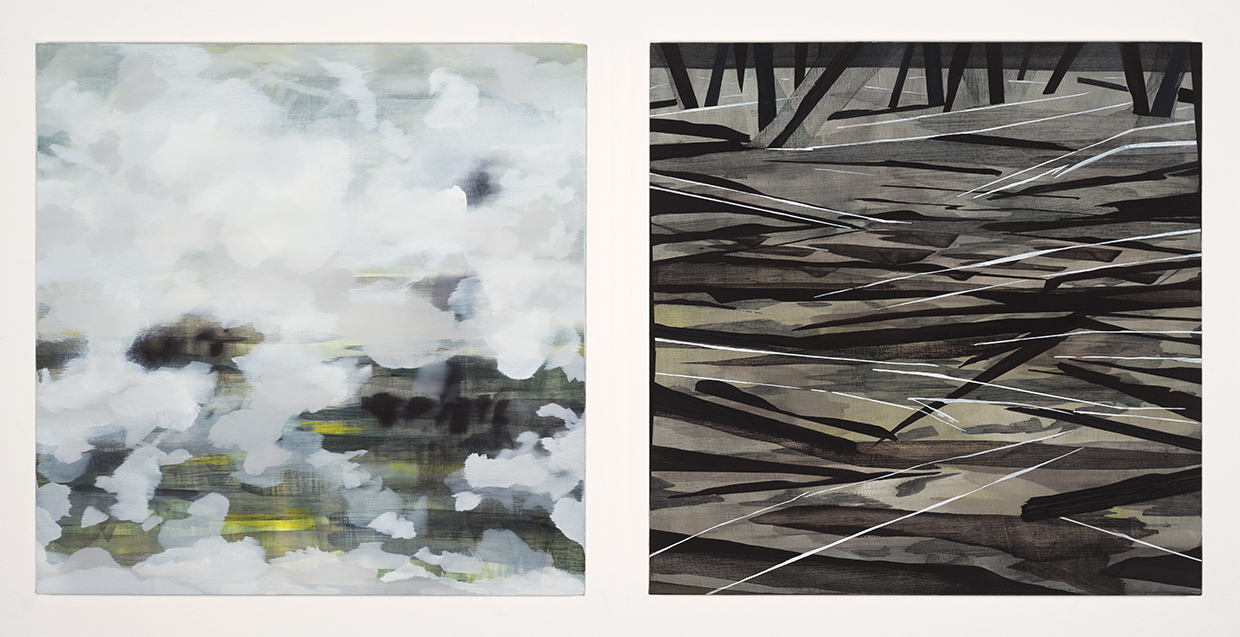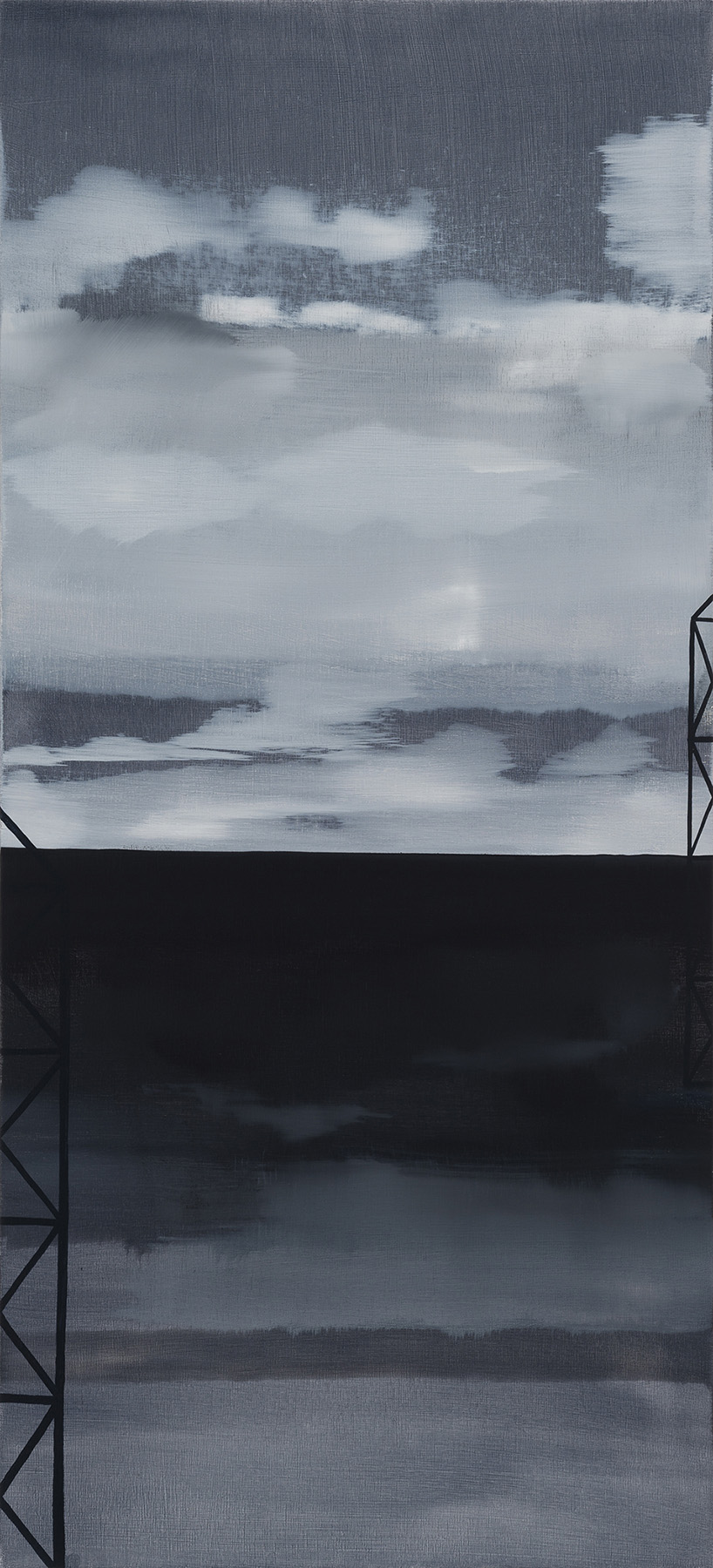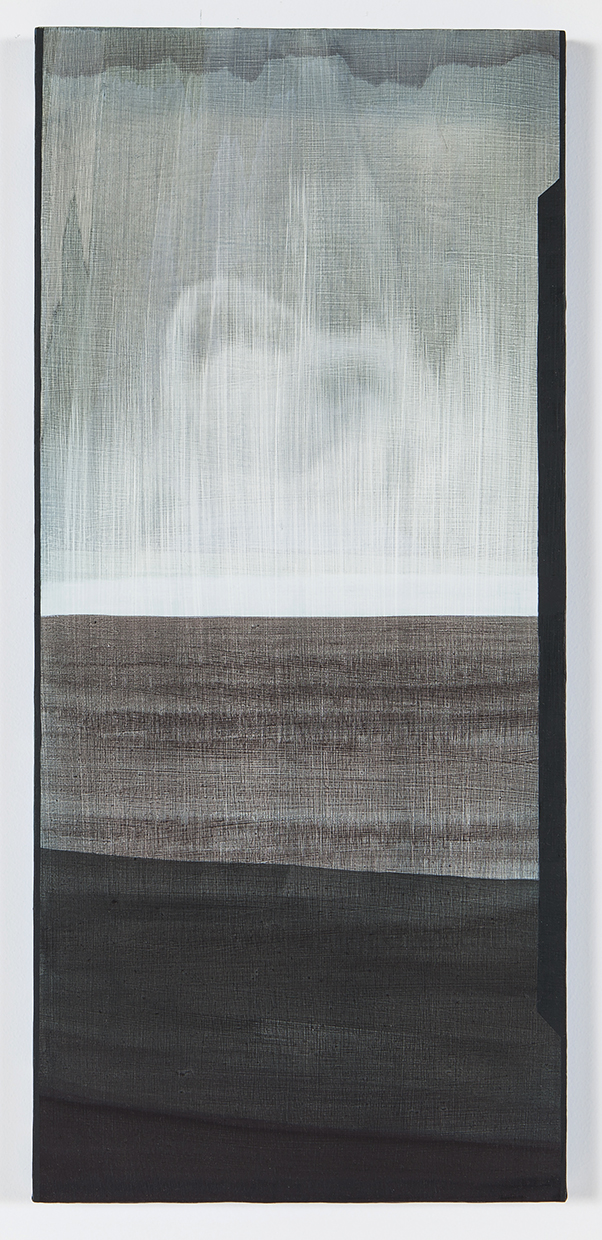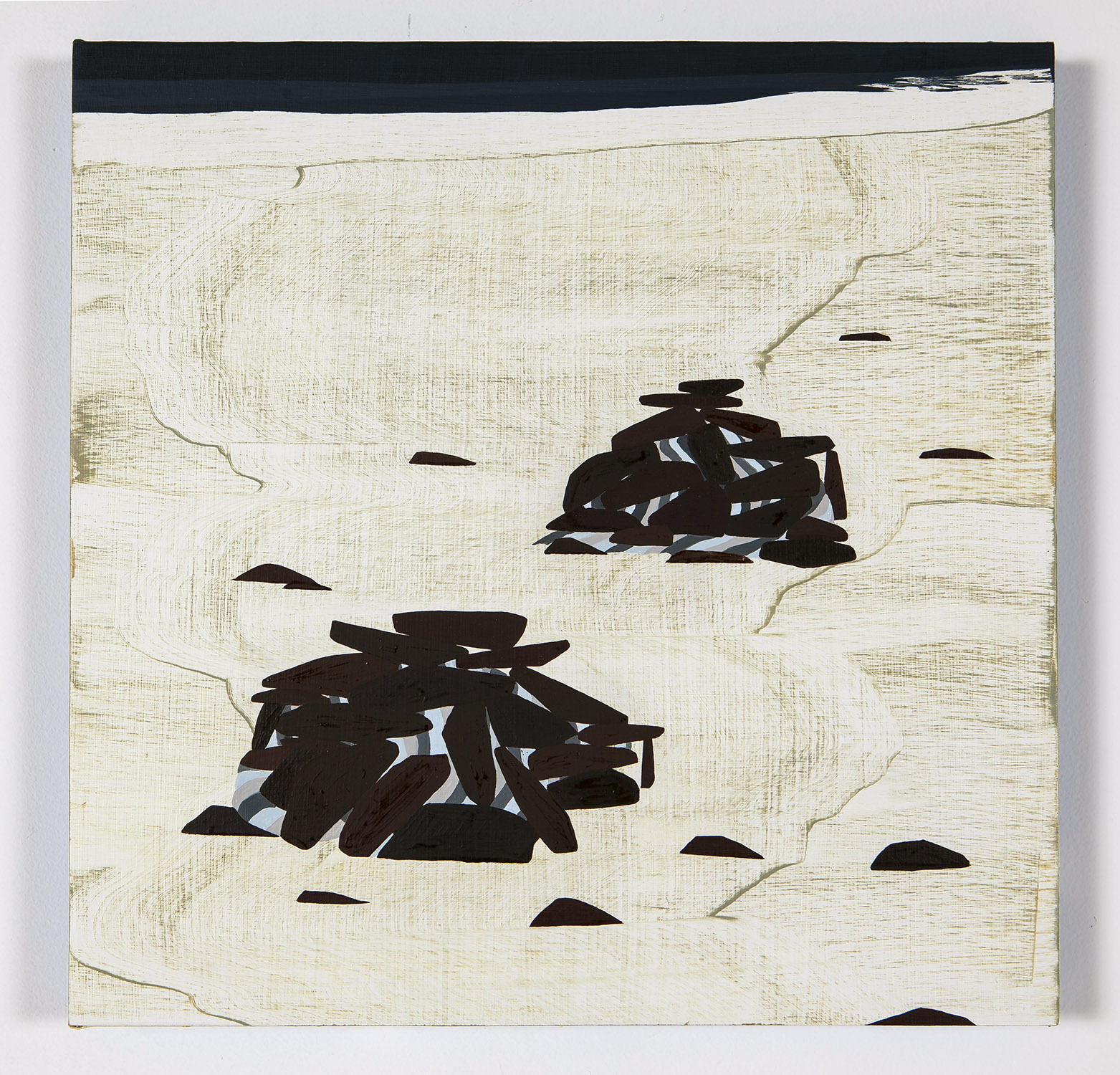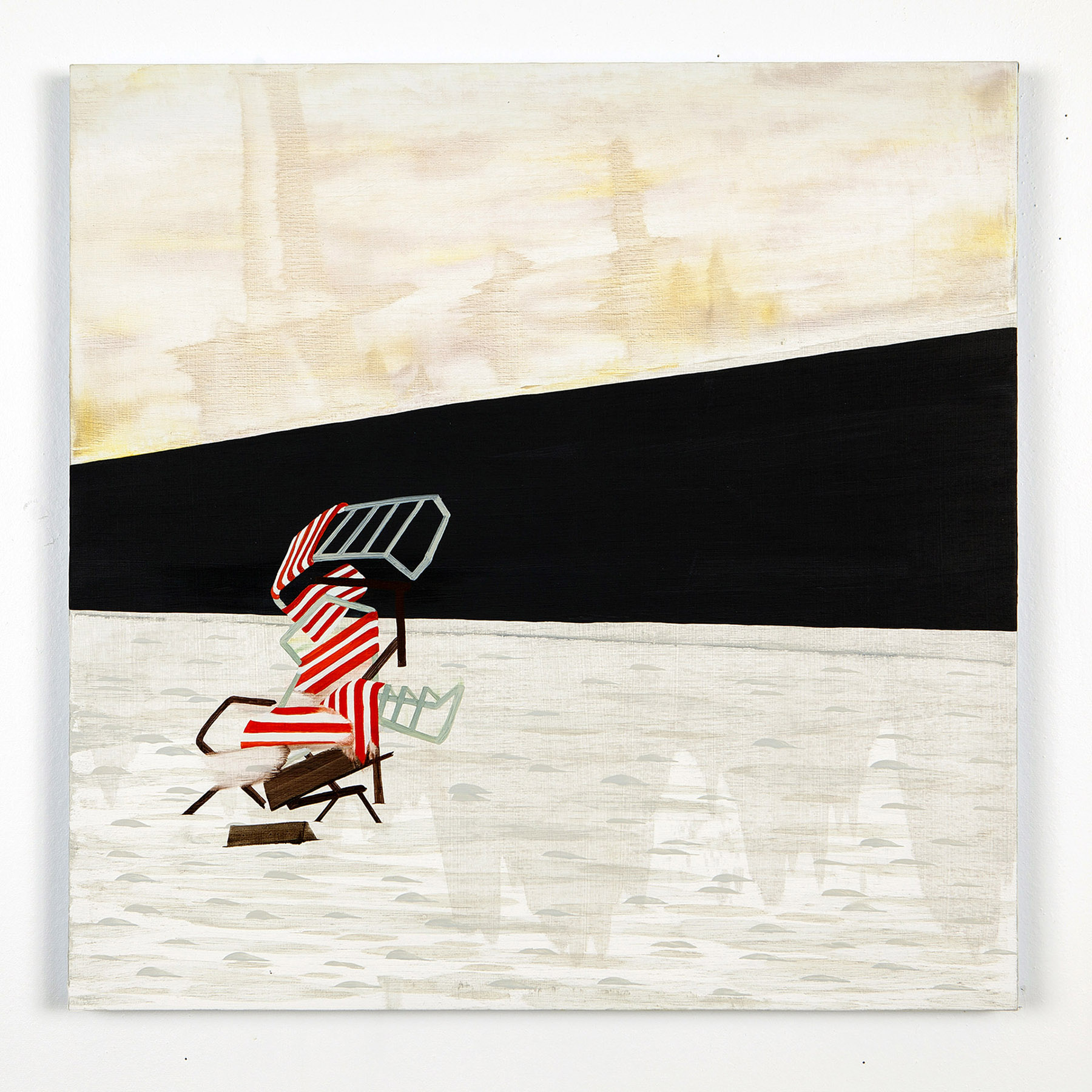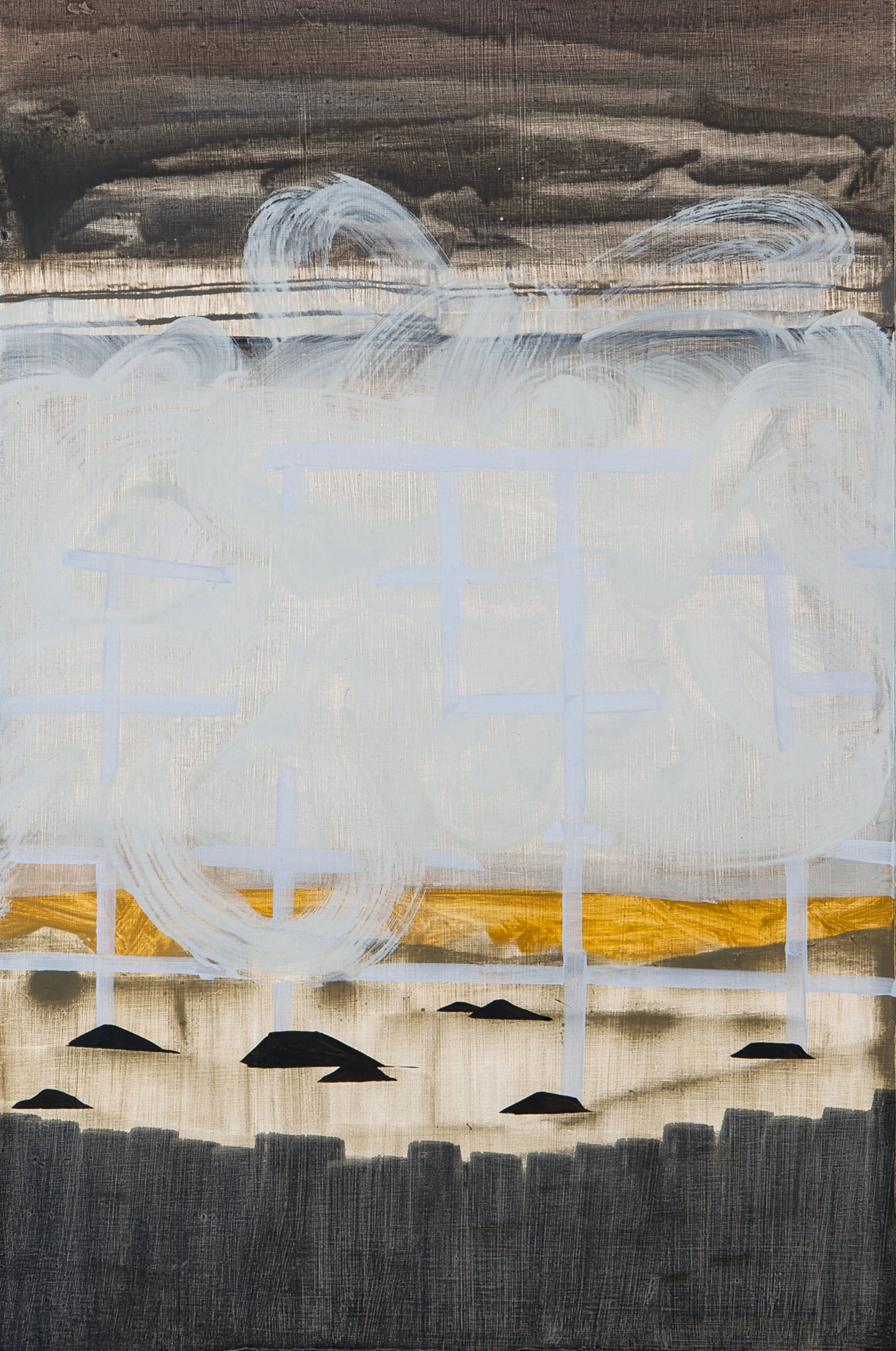Work samples
About Magnolia
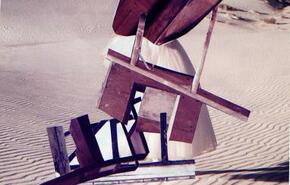
Magnolia Laurie was born in Massachusetts and raised in Puerto Rico. She received her BA in Critical Social Thought from Mount Holyoke College and her MFA from the Mount Royal School of Art at the Maryland Institute College of Art. She has been awarded fellowships and residencies from the Vermont Studio Center, the Virginia Center for the Creative Arts, the Creative Alliance in Baltimore, and the Jentel Foundation in Wyoming. She has also been a recipient of an Individual Artist Grant from… more
REWILDING 2023-25
My creative practice is centered in the field of painting and builds on the traditions of landscape painting to create visual haikus and allegories about our complex relationships to the land. I pull ideas from various fields (climate science, geology, biology, gardening, landscape preservation, etc.) to create new relationships and recontextualize them through a framework of "landscape."
These new paintings are immersive, saturated, and assertive in their colors. Within them, I seek out the sublime in growth that is persistent, invasive, determined, abundant, and lush. My references range from gardens and public parks to vacant lots and rewilded nature preserves. I look for hope, humor, and beauty in moments of tenacious growth and endurance.
These works start with vibrant underpaintings and then build up through layers of mark and gesture, steadily accumulating density. The paintings grow, and the compositions shift, but evidence of that vibrant underpainting persistently endures, pushing its way up through the accumulated layers, much like the weeds that make their way through our sidewalks and mulched flower beds. Relationships of pattern, symmetry, and asymmetry are used to explore ideas of control and cultivation versus chaos and invasiveness in the landscape.
-
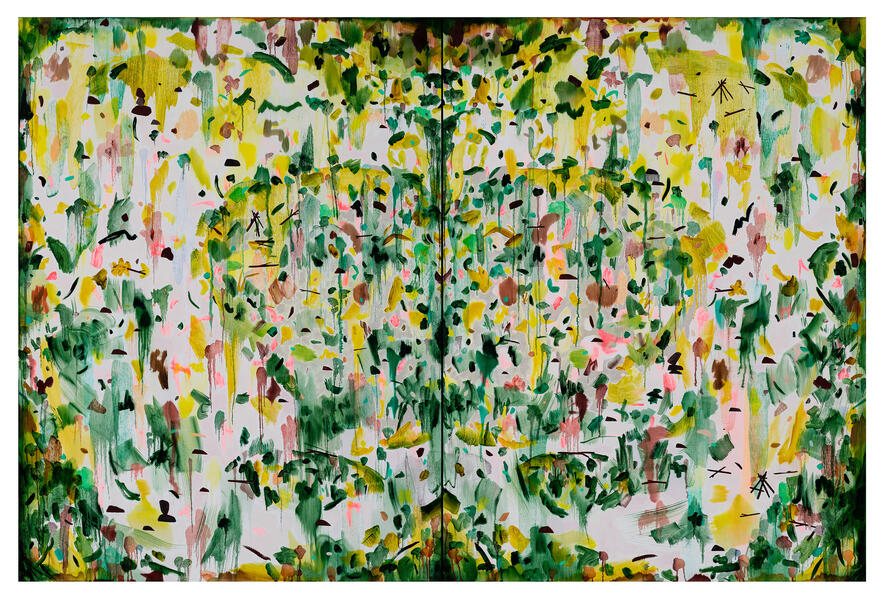 my garden, your battleground
my garden, your battlegroundmy garden, your battleground
2023, oil on panel, 40 x 60 diptych
-
 lean into me
lean into melean into me
2023, oil on panel, 40 x 60 diptych
-
 wilder than me
wilder than mewilder than me
2024, oil on panel, 48 x 36 inches
-
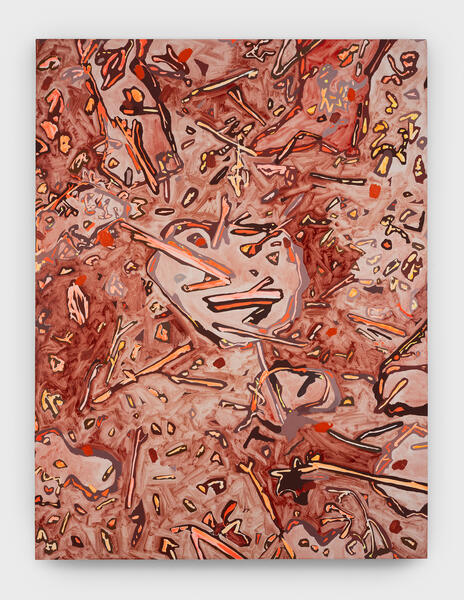 ground - from verb to noun
ground - from verb to nounground - from verb to noun
2024, oil on panel, 48 x 36 inches
-
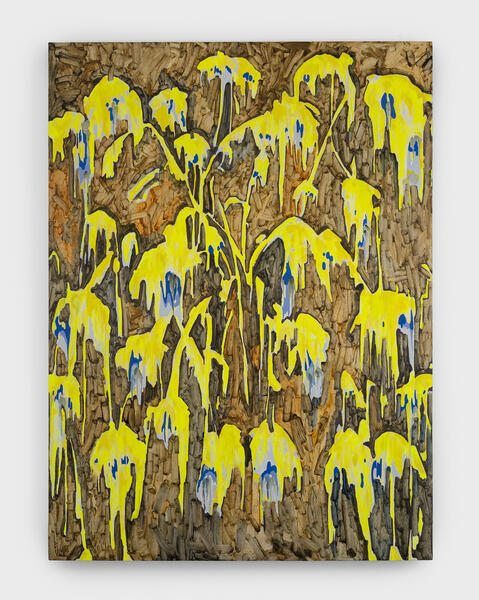 with the weight of gravity
with the weight of gravitywith the weight of gravity
2024, oil on panel, 48 x 36 inches
-
 in a chorus of night swimmers
in a chorus of night swimmersin a chorus of night swimmers
2023, oil on panel diptych, 40 x 60 inches
-
 nocturne (just the fireflies and crickets)
nocturne (just the fireflies and crickets)nocturne (just the fireflies and crickets)
2023, oil on panel, 48 x 36 inches
-
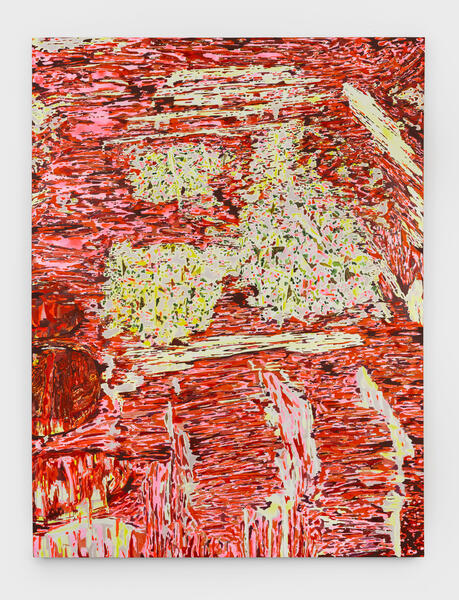 lost in this moment
lost in this momentlost in this moment, 2023 oil and flashe on panel 48 x 36 inches
Available for Purchaselost in this moment, 2023, oil on panel 48 x 36 inches
-
 breaking through
breaking through2024
flashe, acrylic, and oil on panel 48 x 36 inches
48 x 36 inches
feeling our way forward, 2020-2022
Compositionally, the horizon lines in many of the paintings are roughly aligned, although the climate and quality of the landscape changes from one to the next. Like so much in the last few years, this body of work has paused, pivoted, adapted, and then continued along an altered course. Some horizon lines were repositioned, and some slipped out of sight entirely, and an exploration of orientation and vantage point gradually evolved to reflect a condition of disorientation. These works are about the landscape, the environment, and our disorienting distance and proximity to a quickly changing horizon line. Thrown off course, these paintings are about searching and feeling our way forward.
-
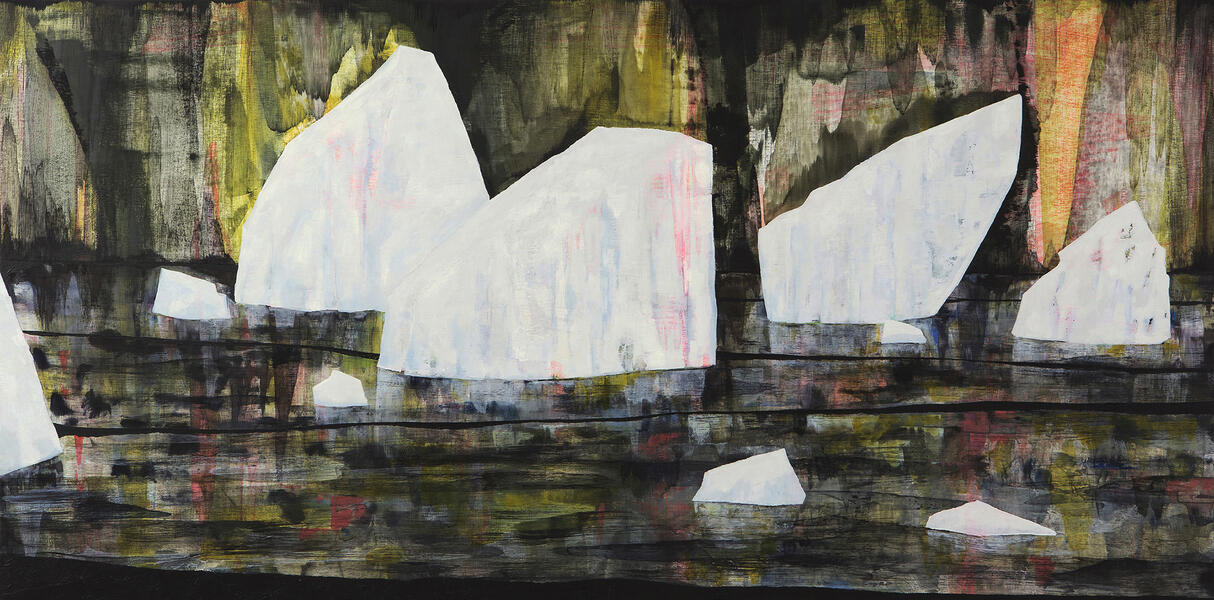 Going, going, goneGoing, going, gone, 2021, oil on panel, 24 x 48 inches
Going, going, goneGoing, going, gone, 2021, oil on panel, 24 x 48 inches -
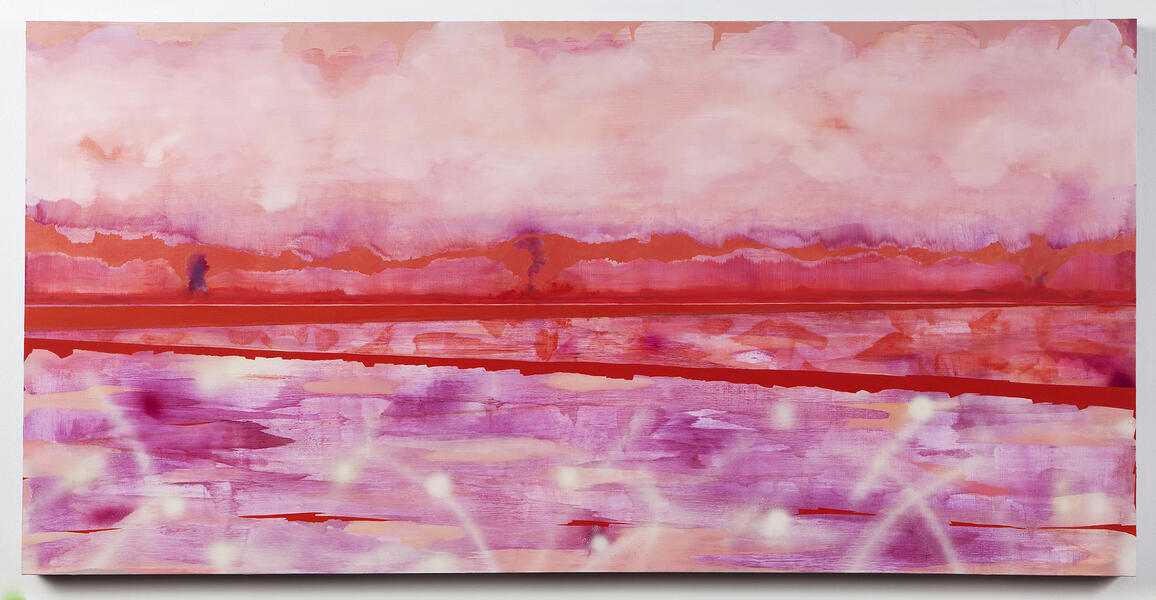 smoke signalssmoke signals 2021, oil on panel, 24 x 48 inches
smoke signalssmoke signals 2021, oil on panel, 24 x 48 inches -
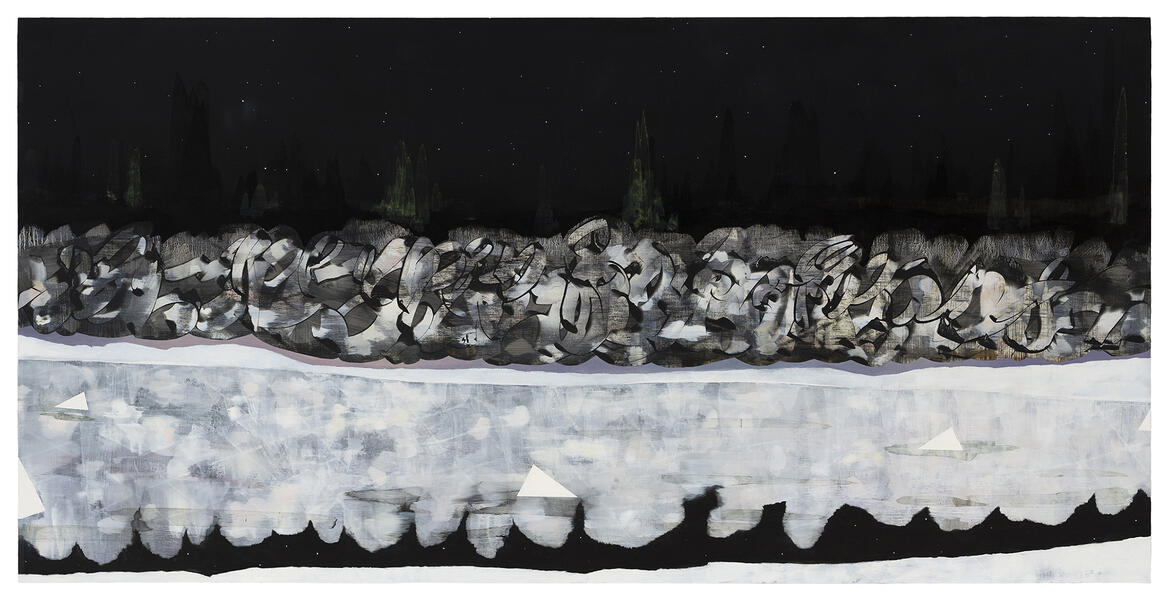 it was there on the horizonit was there on the horizon 2021, oil on panel, 24 x 48 inches
it was there on the horizonit was there on the horizon 2021, oil on panel, 24 x 48 inches -
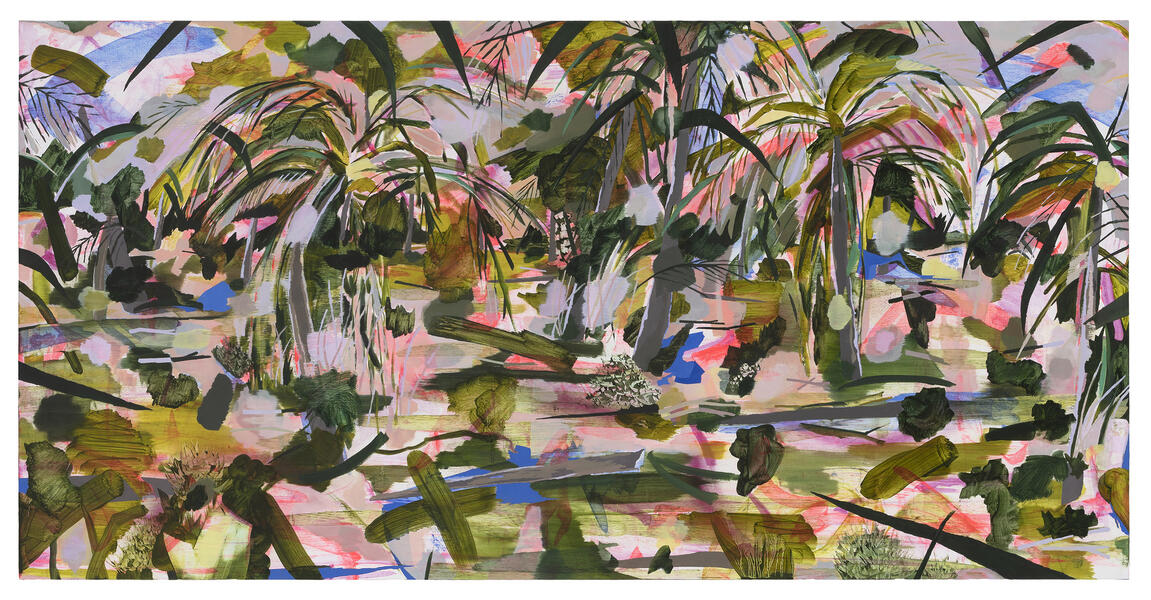 blue, in the wake of the stormblue, in the wake of the storm 2022, oil on panel, 24 x 48 inches
blue, in the wake of the stormblue, in the wake of the storm 2022, oil on panel, 24 x 48 inches -
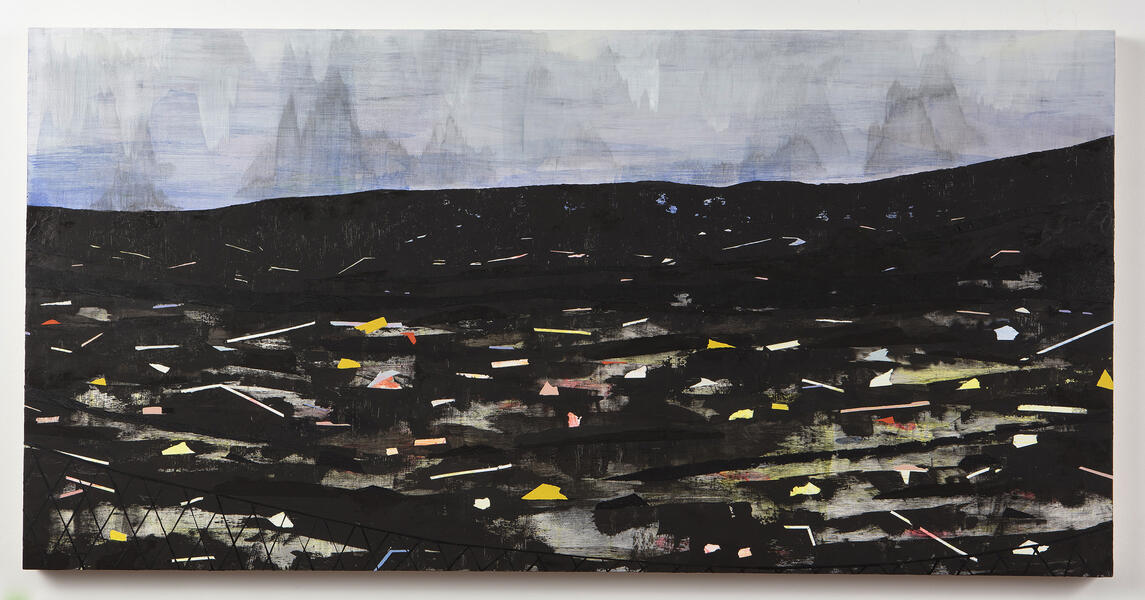 scattered like confettiscattered like confetti 2021, oil on panel, 24 x 48 inches
scattered like confettiscattered like confetti 2021, oil on panel, 24 x 48 inches -
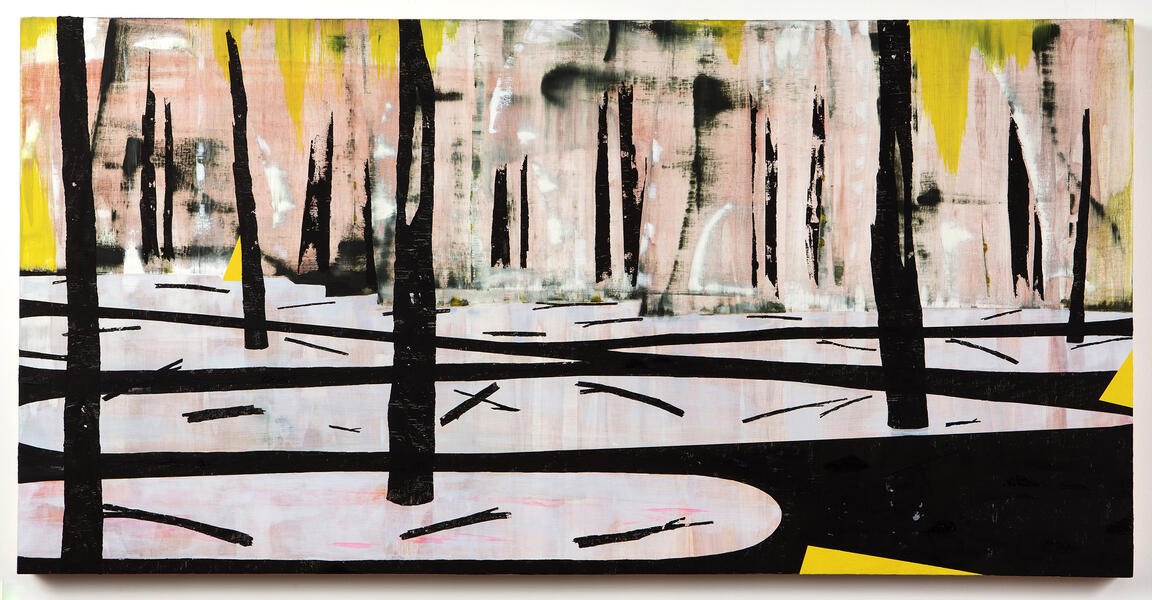 seeping up and in between usseeping up and in between us 2021, oil on panel, 24 x 48 inches
seeping up and in between usseeping up and in between us 2021, oil on panel, 24 x 48 inches -
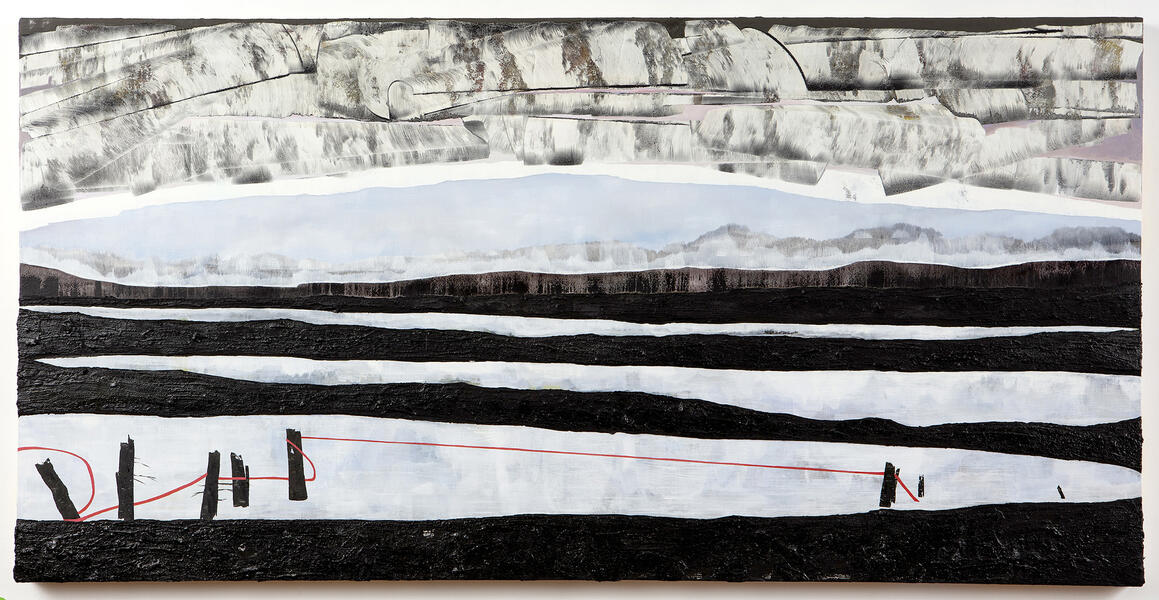 with the rising tideswith the rising tides 2021, oil on panel, 24 x 48 inches
with the rising tideswith the rising tides 2021, oil on panel, 24 x 48 inches -
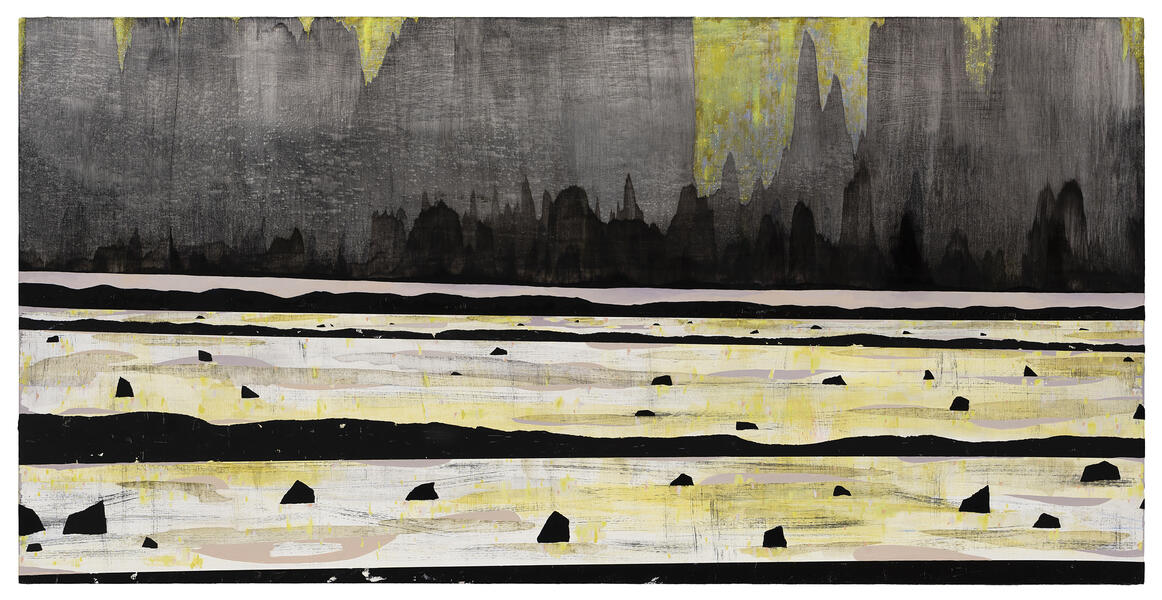 from one marker to the nextfrom one marker to the next 2022, oil on panel, 24 x 48 inches
from one marker to the nextfrom one marker to the next 2022, oil on panel, 24 x 48 inches -
 learning to pivotlearning to pivot 2021, oil on panel, 18 x 18 inches
learning to pivotlearning to pivot 2021, oil on panel, 18 x 18 inches -
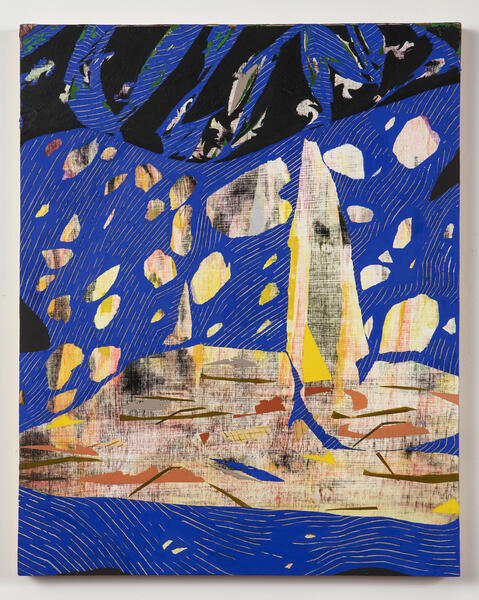 in the remnants of our own doingin the remnants of our own doing 2021, oil on panel, 20 x 16 inches
in the remnants of our own doingin the remnants of our own doing 2021, oil on panel, 20 x 16 inches
Again and Again
Again and Again refers to the repeated cycles happening all around us, from tectonic shift and volcanic activity to the devastating forest fires and the slow new growth that follows. In one sense, the phrase implies a form of persistence or survival. In another, the repetition can articulate a failure to change course.
This new work started from a very physical inclination, a need for the relationship between the materials to be reactive, immediate, and tactile. In this way, the images emerged from a sort of rummaging in dark inky terrain and feeling my way through. I can hold a rock in my hand and hold both a place and a moment in time. I wanted these drawings to feel that way – for the paper to soak up a pigment, an action and a fraction of time, and hold it.
The drawings suggest a geologic span of time and offer a nearly cross-sectional view of landscape – tendencies that complicate a sense of vantage point and question the expectation of a human perspective. References to the sublime, geologic stratification, and global climate change collide in fractured imaginary landscapes. The drawings evolve through a process of adaptation, as each layer of ink, water, and salt add and subtract moisture from the surface. Visual layers repeatedly build up and break down, offering evidence of both immediate and gradual change.
Clusters of wood and plaster branches accompanied the drawings, stacking and leaning throughout the exhibition space. They provided a physical counterweight to the imagined spaces in the drawings.
-
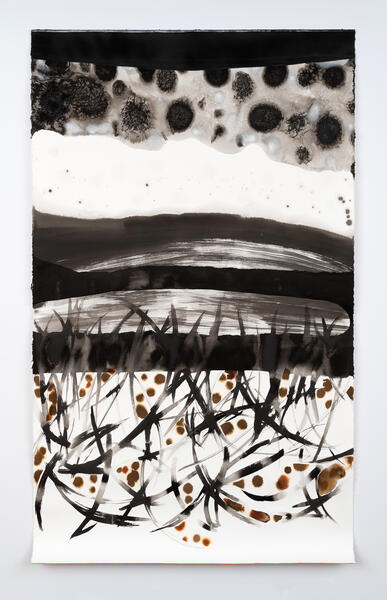 win or lose, it’s just a different rate of changewin or lose, it’s just a different rate of change ink on paper, 42.5 x 71 inches, 2019
win or lose, it’s just a different rate of changewin or lose, it’s just a different rate of change ink on paper, 42.5 x 71 inches, 2019 -
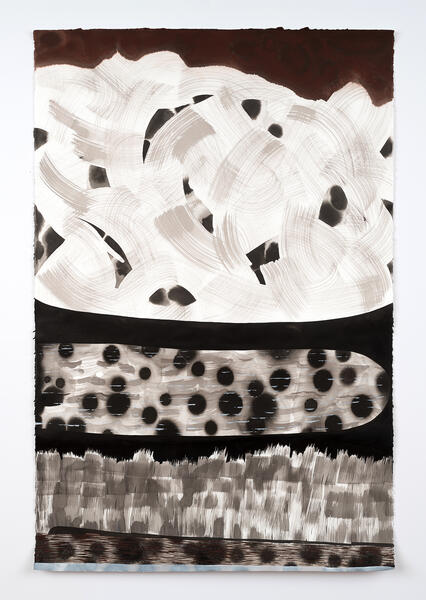 evolving from one to the next, shaped by wind and waterevolving from one to the next, shaped by wind and water ink on paper, 42.5 x 64 inches, 2019
evolving from one to the next, shaped by wind and waterevolving from one to the next, shaped by wind and water ink on paper, 42.5 x 64 inches, 2019 -
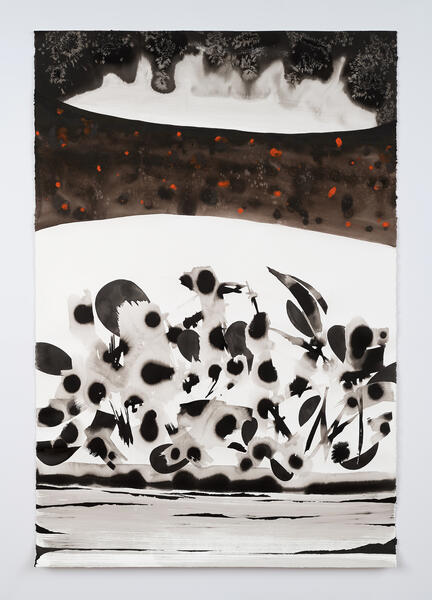 the questions arrived with smoke and ashthe questions arrived with smoke and ash ink on paper, 42.5 x 63 inches, 2019
the questions arrived with smoke and ashthe questions arrived with smoke and ash ink on paper, 42.5 x 63 inches, 2019 -
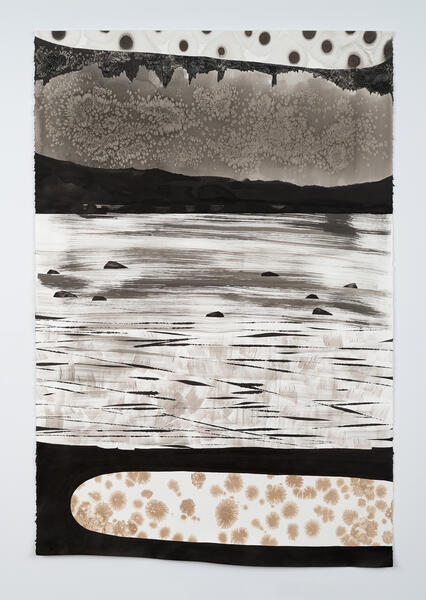 in the wake of dead icein the wake of dead ice, ink on paper, 42.5 x 64 inches, 2019
in the wake of dead icein the wake of dead ice, ink on paper, 42.5 x 64 inches, 2019 -
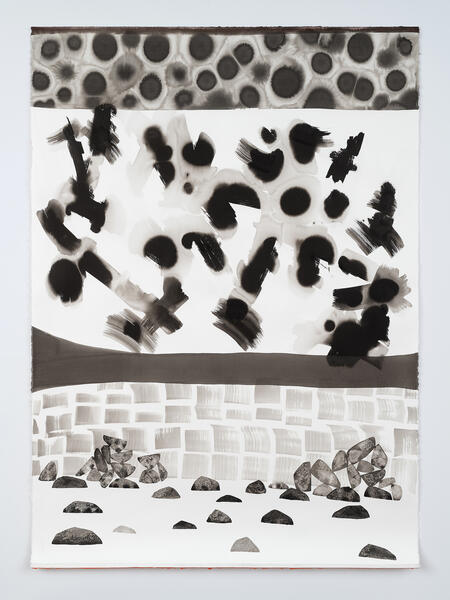 an archive in every stonean archive in every stone ink on paper, 42.5 x 60 inches, 2019
an archive in every stonean archive in every stone ink on paper, 42.5 x 60 inches, 2019 -
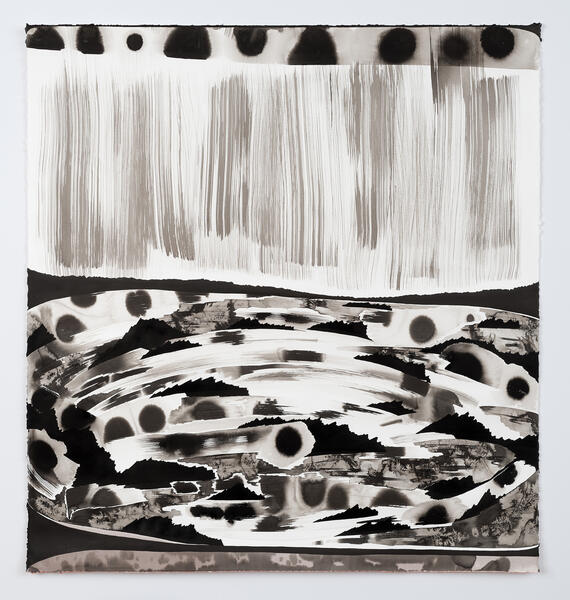 Laurie006.jpglisten,ʻaʻā lava moves with a sound like crockery breaking ink on paper, 42.5 x 45 inches, 2019
Laurie006.jpglisten,ʻaʻā lava moves with a sound like crockery breaking ink on paper, 42.5 x 45 inches, 2019 -
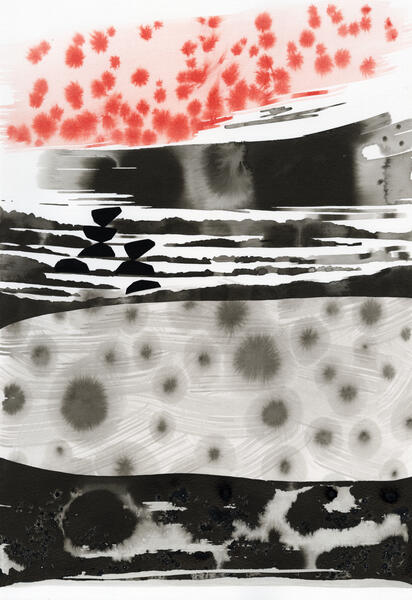 along the fault linealong the fault line ink on paper, 18 x 12 inches, 2019
along the fault linealong the fault line ink on paper, 18 x 12 inches, 2019 -
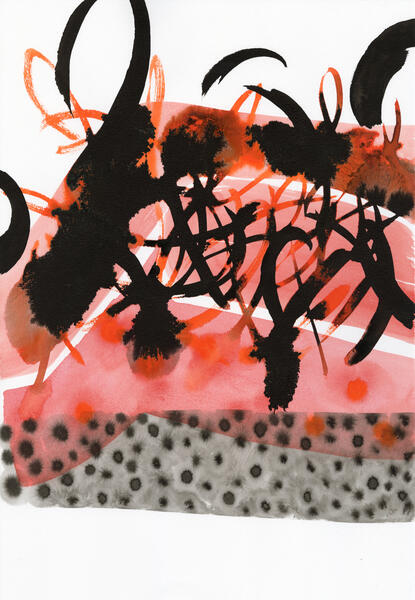 a beginning, again and again (for Ms. Stein)a beginning, again and again (for Ms. Stein) ink on paper, 18 x 12 inches, 2019
a beginning, again and again (for Ms. Stein)a beginning, again and again (for Ms. Stein) ink on paper, 18 x 12 inches, 2019 -
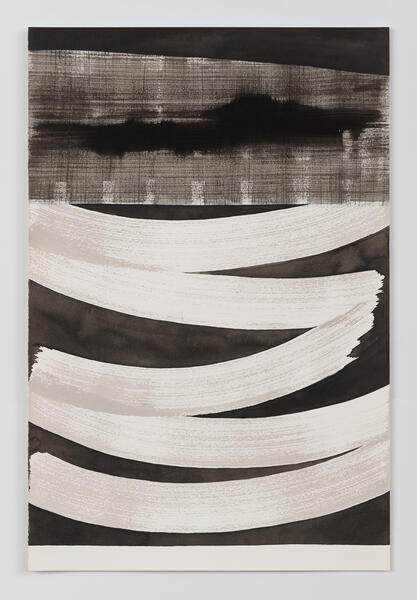 deeper downdeeper down ink on paper, 18 x 12 inches, 2019
deeper downdeeper down ink on paper, 18 x 12 inches, 2019 -
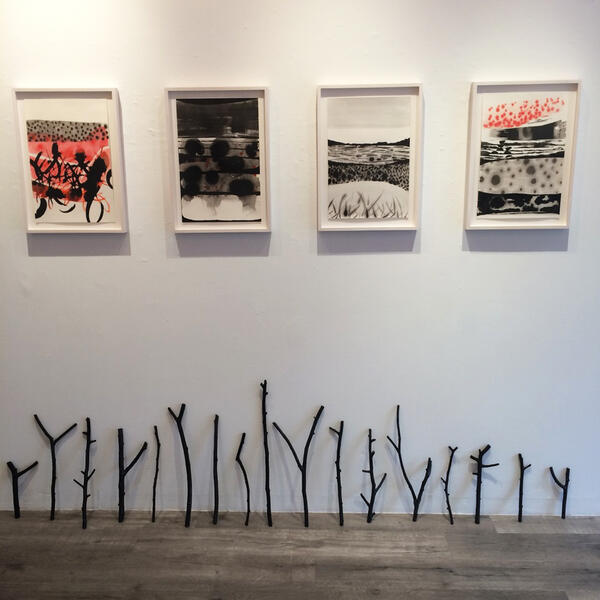 gather, Installation viewInstallation view framed drawings and sculptural installation. Sculpture: gather, wood, plaster, and ink, scale and installation varies, 2019
gather, Installation viewInstallation view framed drawings and sculptural installation. Sculpture: gather, wood, plaster, and ink, scale and installation varies, 2019
further yet closer still
and his vision unfolds at ground level, as he goes along
Tim Ingold, The Life of Lines, Routledge
The works in further yet closer still are honest in their wandering, each painting marking an encounter with information that I needed to process and translate in order to better understand. Some paintings stay closer to their references, while others are allowed to detour into augmentation and embellishment. The colors in these works range from emotional saturation to restrained precision and starkness.
Borders, fences, and framing devices are repeated motifs in these new paintings, they denote division, proximity, and distance. There is no doubt that we are living in a time of division and very tangible transition. These works are about looking and thinking, bearing witness to environmental and cultural rifts, while trying to move forward.
further yet closer still can refer to the act of wandering, which is also likened to the process of making, when you sometimes need to lose yourself in order to find what you are looking for. The phrase also seems apt to describe the somewhat conflicted state of our social and political environment - from which we will hopefully find our direction forward.
-
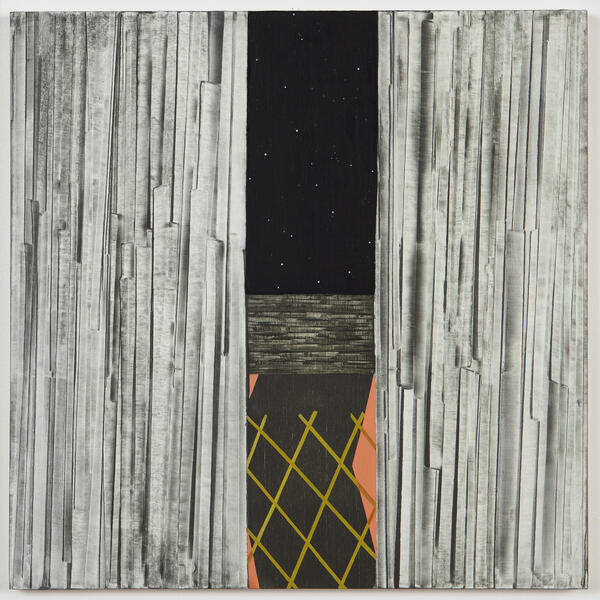 built for fictions of the presentbuilt for fictions of the present, 18 x 18 inches, oil on panel, 2018
built for fictions of the presentbuilt for fictions of the present, 18 x 18 inches, oil on panel, 2018 -
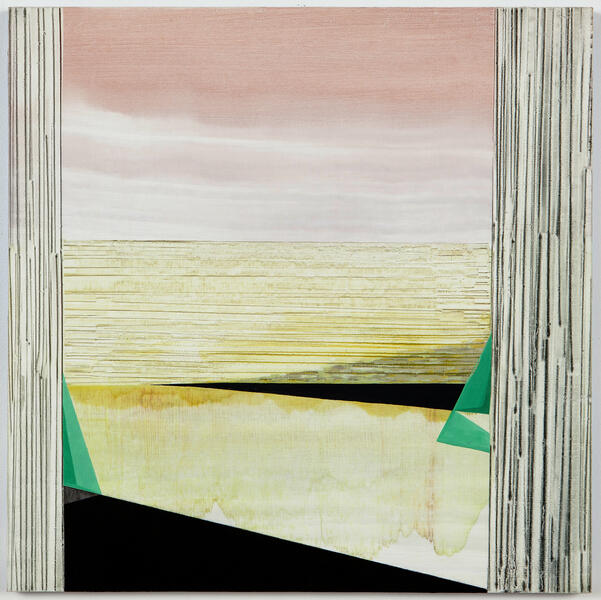 built on fictions of the pastbuilt on fictions of the past, 2018, oil on panel, 18 x 18 inches
built on fictions of the pastbuilt on fictions of the past, 2018, oil on panel, 18 x 18 inches -
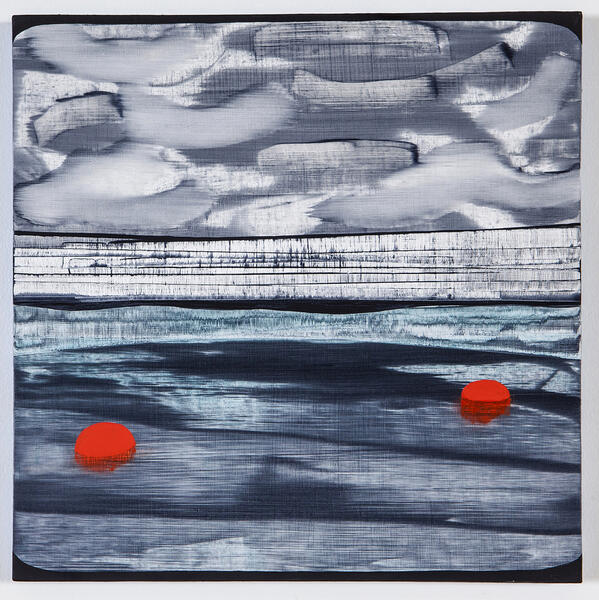 they marked the borders, the barriers, and the changing tidethey marked the borders, the barriers, and the changing tide, 12 x 12 inches, oil on panel, 2017
they marked the borders, the barriers, and the changing tidethey marked the borders, the barriers, and the changing tide, 12 x 12 inches, oil on panel, 2017 -
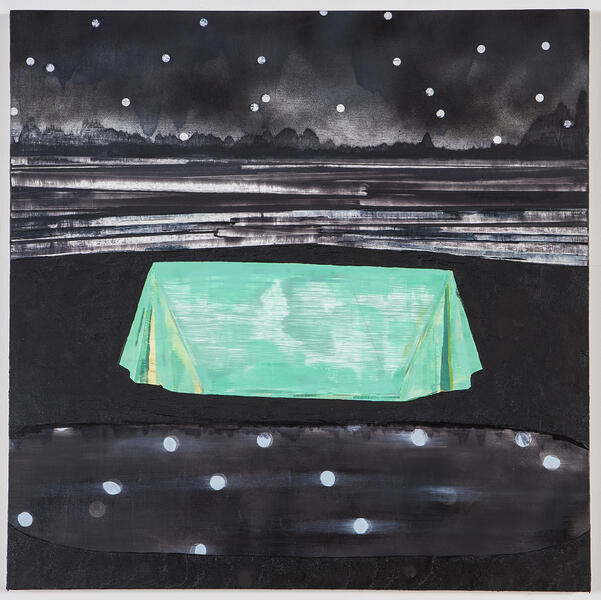 to be further yet closer stillto be further yet closer still, 2017, oil on panel, 18 x 18 inches
to be further yet closer stillto be further yet closer still, 2017, oil on panel, 18 x 18 inches -
 they list disasters like dark poemsthey list disasters like dark poems, 2018, oil on panel, 16 x 20 inches
they list disasters like dark poemsthey list disasters like dark poems, 2018, oil on panel, 16 x 20 inches -
 between forethought and hindsightbetween forethought and hindsight, 2018, oil on panel, 12 x 24 inches
between forethought and hindsightbetween forethought and hindsight, 2018, oil on panel, 12 x 24 inches -
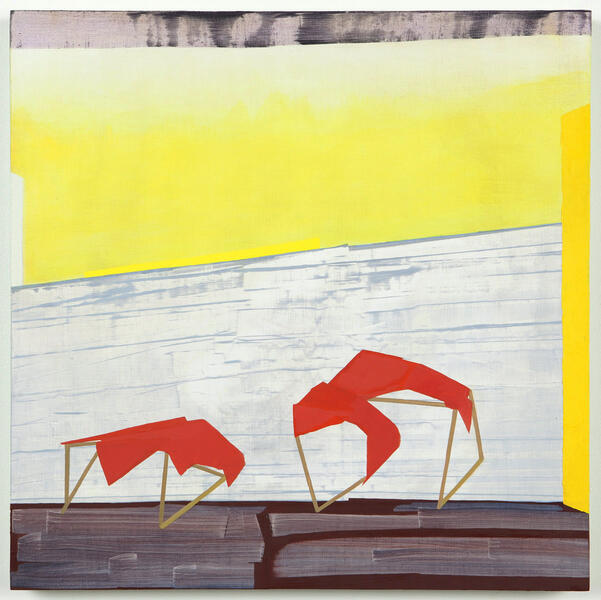 how we shape each otherhow we shape each other, 2018, oil on panel, 18 x 18 inches
how we shape each otherhow we shape each other, 2018, oil on panel, 18 x 18 inches -
 pending (November 1963)pending (November 1963), 2017, oil on panel, 12 x 12 inches
pending (November 1963)pending (November 1963), 2017, oil on panel, 12 x 12 inches -
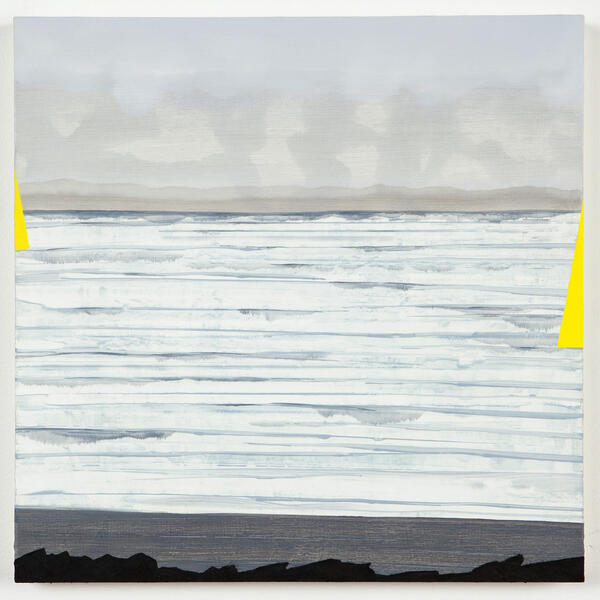 how far is farhow far is far, 2018, oil on panel, 12 x 12
how far is farhow far is far, 2018, oil on panel, 12 x 12 -
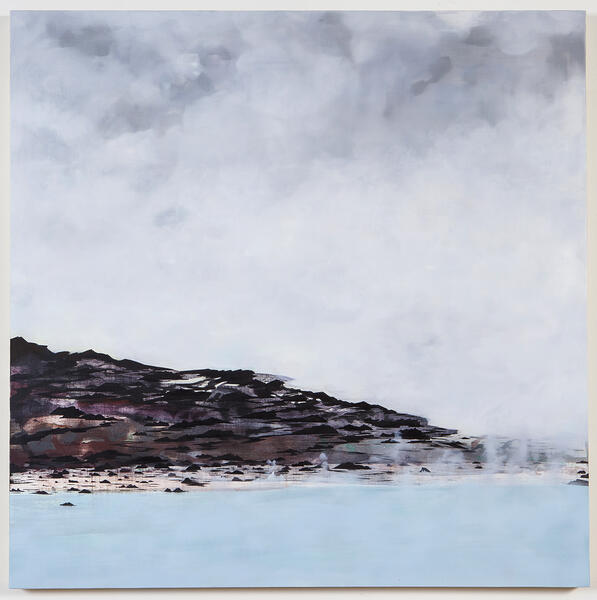 where earth and sky mix and minglewhere earth and sky mix and mingle, 2018, oil on panel, 36 x 36 inches
where earth and sky mix and minglewhere earth and sky mix and mingle, 2018, oil on panel, 36 x 36 inches
GROUND SHIFT
-
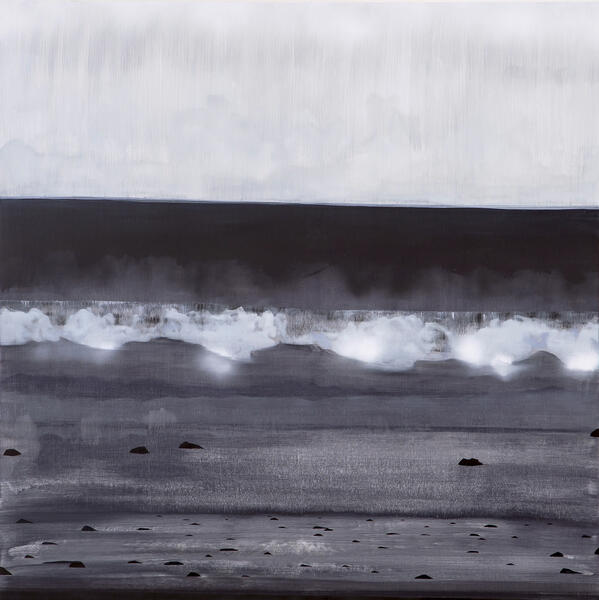 I asked the horizon line, it replied with a well worn stoneI asked the horizon line, it replied with a well worn stone 2016, oil on panel, 36 x 36 inches
I asked the horizon line, it replied with a well worn stoneI asked the horizon line, it replied with a well worn stone 2016, oil on panel, 36 x 36 inches -
 if we could drill wisdom from a stone2016, oil on panel, 24 x 24 inches
if we could drill wisdom from a stone2016, oil on panel, 24 x 24 inches -
 to get at the center of the worldto get at the center of the world 2016, oil on panel, 12 x 12 inches
to get at the center of the worldto get at the center of the world 2016, oil on panel, 12 x 12 inches -
 wider than the skywider than the sky, 2016, oil on panel, 36 x 36 inches
wider than the skywider than the sky, 2016, oil on panel, 36 x 36 inches -
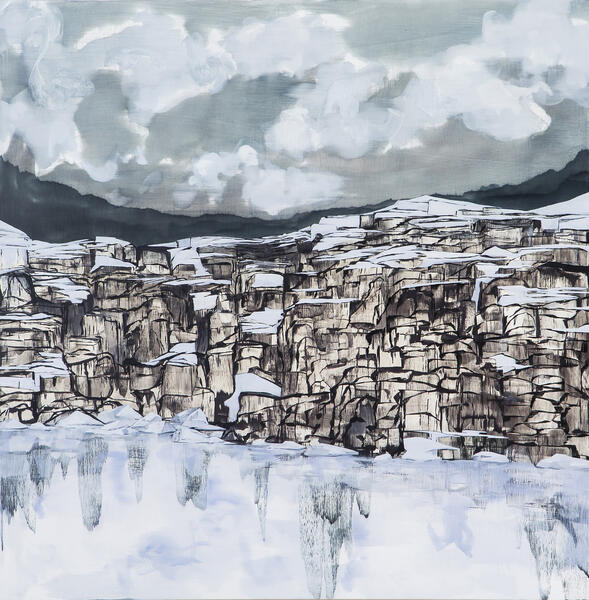 just a crack in the crust, marking time and changejust a crack in the crust, marking time and change, 2016, oil on panel, 36 x 36 inches
just a crack in the crust, marking time and changejust a crack in the crust, marking time and change, 2016, oil on panel, 36 x 36 inches -
 revel in the space betweenrevel in the space between, 2016, oil on panel, 36 x 36 inches
revel in the space betweenrevel in the space between, 2016, oil on panel, 36 x 36 inches -
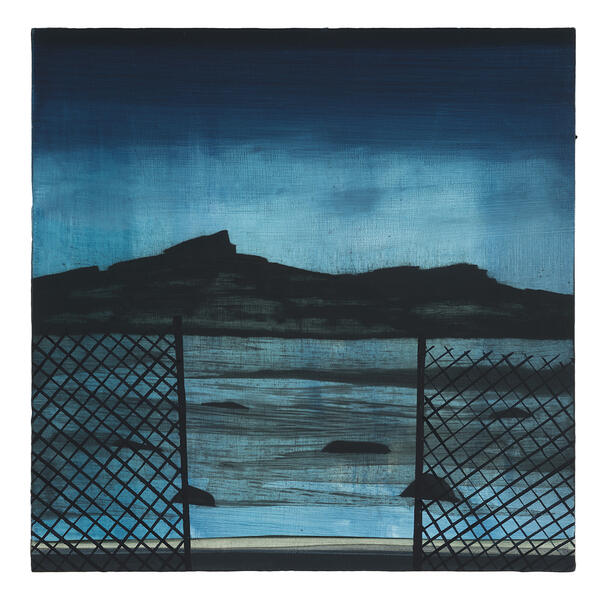 to wonder what could, what would beto wonder what could, what would be 2016, oil on panel, 12 x 12 inches
to wonder what could, what would beto wonder what could, what would be 2016, oil on panel, 12 x 12 inches -
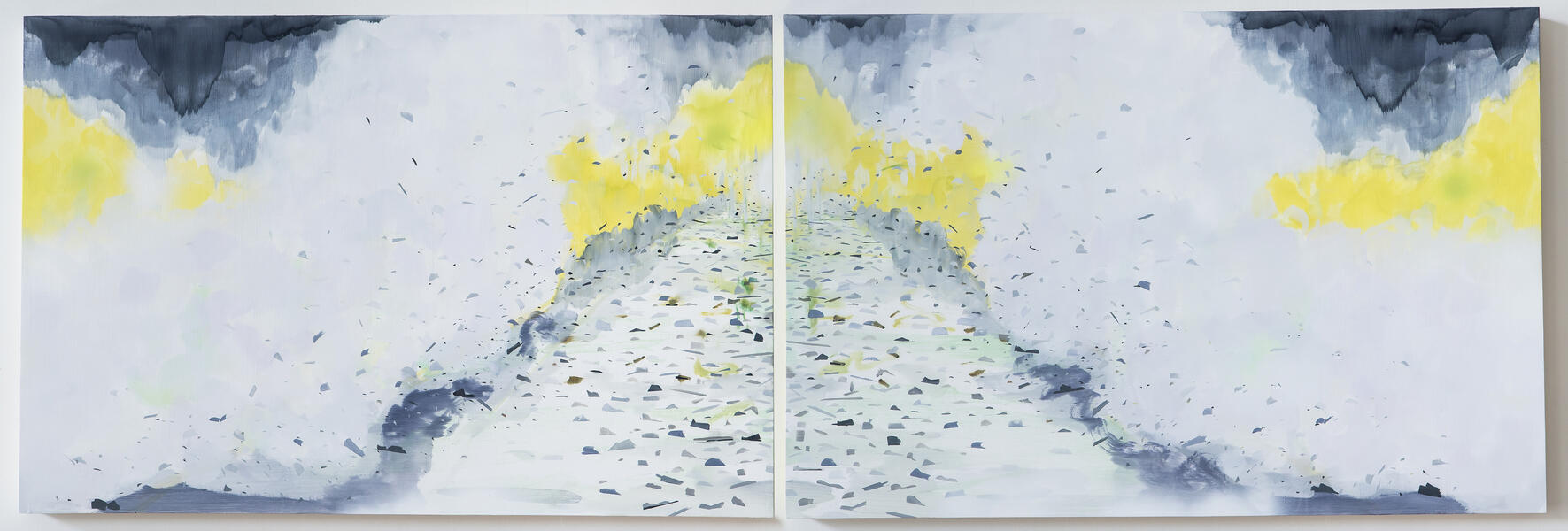 how to lose without negotiatinghow to lose without negotiating 2016, oil on panel, Diptych 24 x 73 inches, each panel is 24 x 36 inches
how to lose without negotiatinghow to lose without negotiating 2016, oil on panel, Diptych 24 x 73 inches, each panel is 24 x 36 inches -
 to wander across burnt land, with anticipation and hopeto wander across burnt land, with anticipation and hope 2016, oil on panel, 36 x 36 inches
to wander across burnt land, with anticipation and hopeto wander across burnt land, with anticipation and hope 2016, oil on panel, 36 x 36 inches -
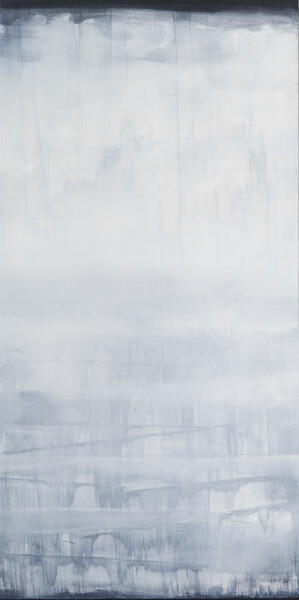 there was no circumventing the weatherthere was no circumventing the weather 2016, oil on panel, 24 x 12 inches
there was no circumventing the weatherthere was no circumventing the weather 2016, oil on panel, 24 x 12 inches
Here and Now
These recent paintings place the viewer inside looking out. We are near but isolated from the landscape outside. Snowstorms and dense fog, stark desert heat, and barren forest are set in contrast to the calm of the contained and domesticated nature we create with houseplants. The unpredictable outside is distanced by the slight framing device of a windowsill, a partially drawn shade, or the foreground intrusion of a houseplant. Created throughout the height of the 2016 presidential election, the paintings were a way for me to address the idea of vantage point. Compositionally they place you in front of a view and invite you to look out into the distance, but hold your attention in the foreground. They are intimate paintings revealing personal worlds, isolated bubbles, contradicting realities and a tension between the near and far.
Some paintings are hung on the walls while others occupy custom-made wooden structures that hover between sculpture and furniture. Mounted on structures, the paintings stand in the space with the viewer. Included with these structures were a number of collected objects: rocks, worn bricks, mirrors, and potted plants. Through placement and composition, these different objects create an installation that echoes the ideas of vantage point and personal views found in the paintings. It also invites the viewer to move through space and encounter the paintings and objects from a number of different views, creating an opportunity for discovery and new perspectives.
-
 compared to the vast unknowncompared to the vast unknown, 2016, oil on panel, 12 x 12 inches
compared to the vast unknowncompared to the vast unknown, 2016, oil on panel, 12 x 12 inches -
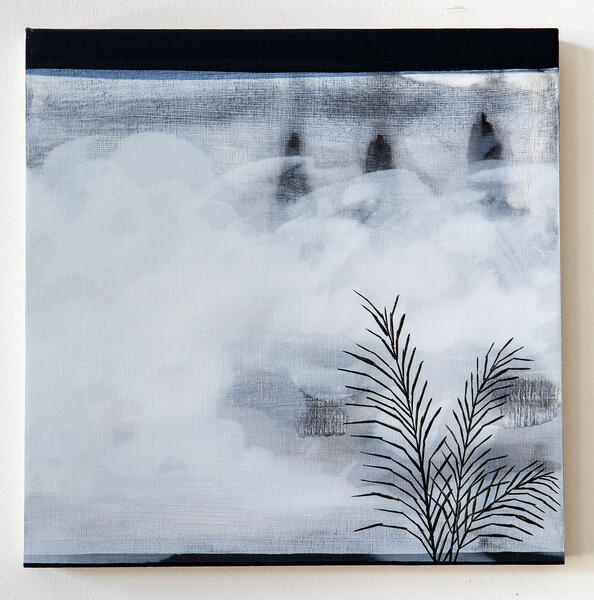 from here to there, 2016, oil on panel, 12 x 12 inchesfrom here to there, 2016, oil on panel, 12 x 12 inches
from here to there, 2016, oil on panel, 12 x 12 inchesfrom here to there, 2016, oil on panel, 12 x 12 inches -
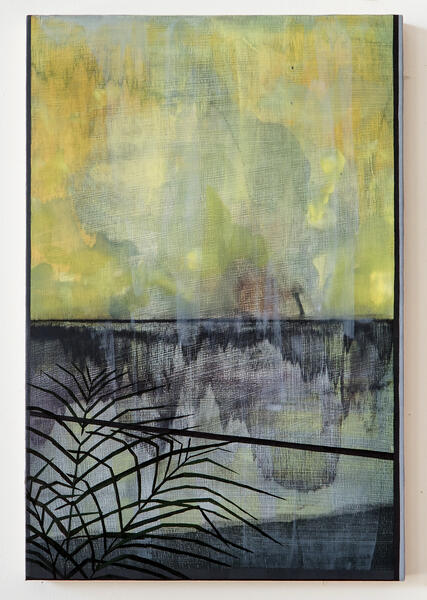 scorched, there was an ache between us, 2016, oil on panel, 12 x 18 inchesscorched, there was an ache between us, 2016, oil on panel, 12 x 18 inches
scorched, there was an ache between us, 2016, oil on panel, 12 x 18 inchesscorched, there was an ache between us, 2016, oil on panel, 12 x 18 inches -
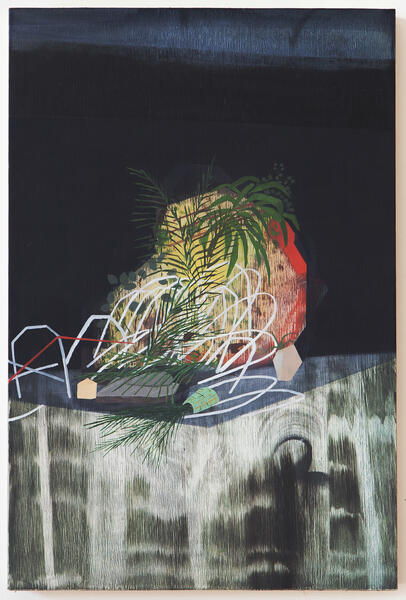 roots resist the need to up and move, 2016, oil on panel, 12 x 18 inchesroots resist the need to up and move, 2016, oil on panel, 12 x 18 inches
roots resist the need to up and move, 2016, oil on panel, 12 x 18 inchesroots resist the need to up and move, 2016, oil on panel, 12 x 18 inches -
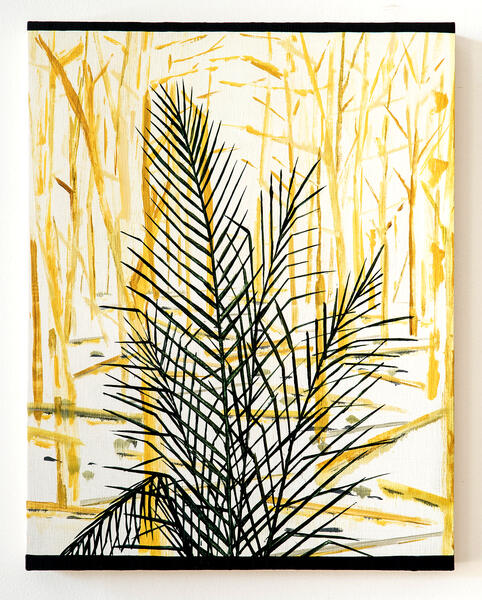 noting north and south, 2016, oil on panel, 11 x 14 inchesnoting north and south, 2016, oil on panel, 11 x 14 inches
noting north and south, 2016, oil on panel, 11 x 14 inchesnoting north and south, 2016, oil on panel, 11 x 14 inches -
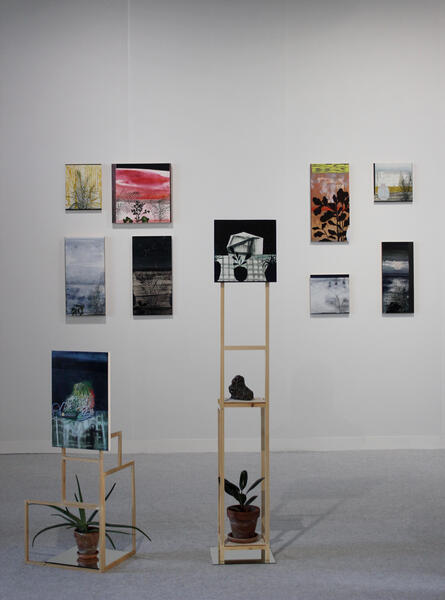 Installation view
Installation view -
 Installation view at McDaniel CollegeHere and Now paintings, Installation view at McDaniel College. The paintings were show with wooden stands, mirror tiles, potted plants, and rocks collected from the Chesapeake Bay.
Installation view at McDaniel CollegeHere and Now paintings, Installation view at McDaniel College. The paintings were show with wooden stands, mirror tiles, potted plants, and rocks collected from the Chesapeake Bay. -
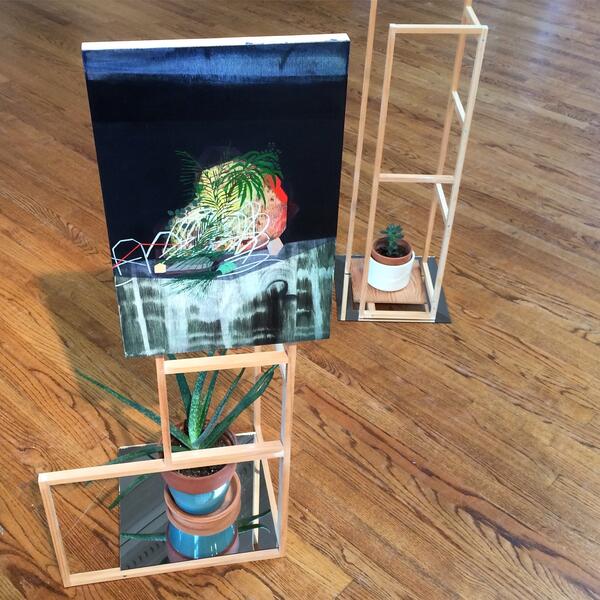 Detail, roots resist the need to up and moveroots resist the need to up and move, 2016, oil on panel, 12 x 18 inches Installation view includes: 15 x 36 x 12 wooden stand,12 x 12 mirror tiles, potted aloe plant
Detail, roots resist the need to up and moveroots resist the need to up and move, 2016, oil on panel, 12 x 18 inches Installation view includes: 15 x 36 x 12 wooden stand,12 x 12 mirror tiles, potted aloe plant -
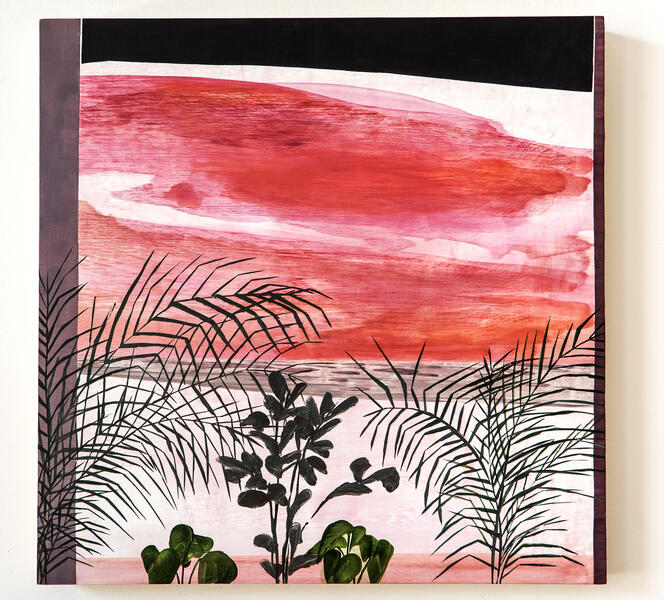 the outline of a familiar image, 2016, oil on panel, 18 x 18 inchesthe outline of a familiar image, 2016, oil on panel, 18 x 18 inches
the outline of a familiar image, 2016, oil on panel, 18 x 18 inchesthe outline of a familiar image, 2016, oil on panel, 18 x 18 inches -
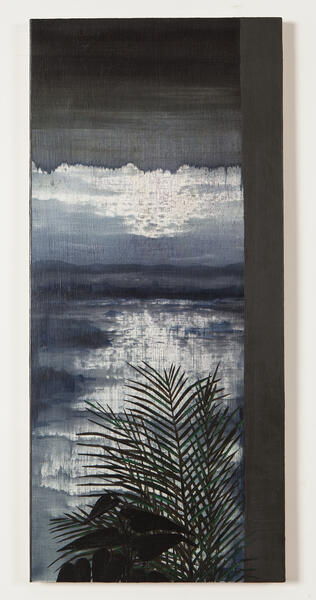 even the light seemed to mutter goodbye, 2017, oil on panel, 10 x 24 incheseven the light seemed to mutter goodbye, 2017, oil on panel, 10 x 24 inches
even the light seemed to mutter goodbye, 2017, oil on panel, 10 x 24 incheseven the light seemed to mutter goodbye, 2017, oil on panel, 10 x 24 inches
Landmark : Paralax Views
Just as vantage point impacts our opinions, physicality impacts our attention. We relate to information presented in a two-dimensional space differently than we do to that in three-dimensional space, things that occupy our space command our attention. To recognize that fact, some paintings are shown on the walls while others occupy custom-made wooden structures. These structures bring the paintings off of the wall and into an awkwardly active and insistent space that wanders in a non-committal manner between sculpture, picket-sign, billboard, and furniture.
This work was featured in the Baltimore Museum of Art as part of the 2015 Sondheim Prize Finalist Exhibition.
-
 ash and moss, hold us together2015 Oil on panel 2 panels, 24” x 24” each
ash and moss, hold us together2015 Oil on panel 2 panels, 24” x 24” each -
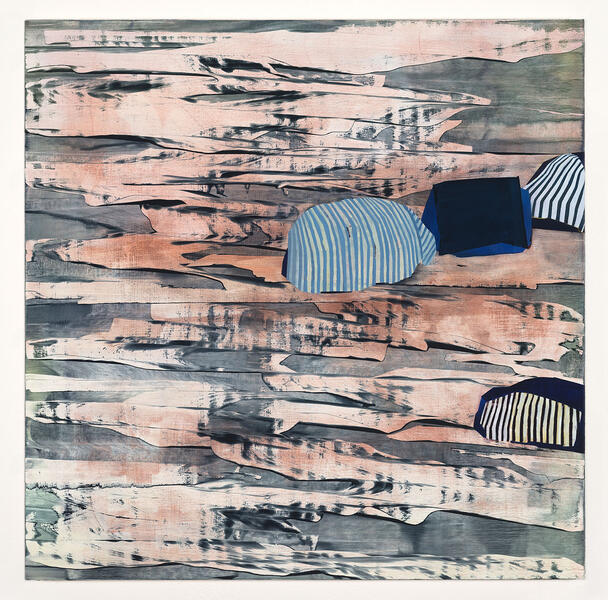 slapstick, a coincidence of humor and melancholy2015 Oil on panel 24 x 24 inches
slapstick, a coincidence of humor and melancholy2015 Oil on panel 24 x 24 inches -
 new geography lessons with oil and water2015 Oil on panel 54” x 18”
new geography lessons with oil and water2015 Oil on panel 54” x 18” -
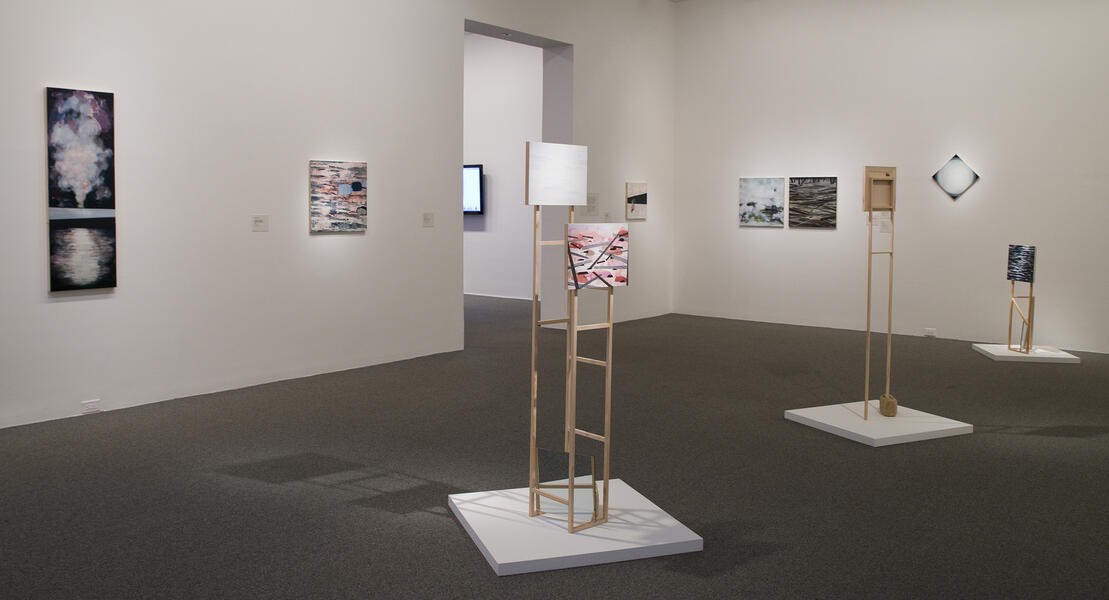 Exhibition view at BMA
Exhibition view at BMA -
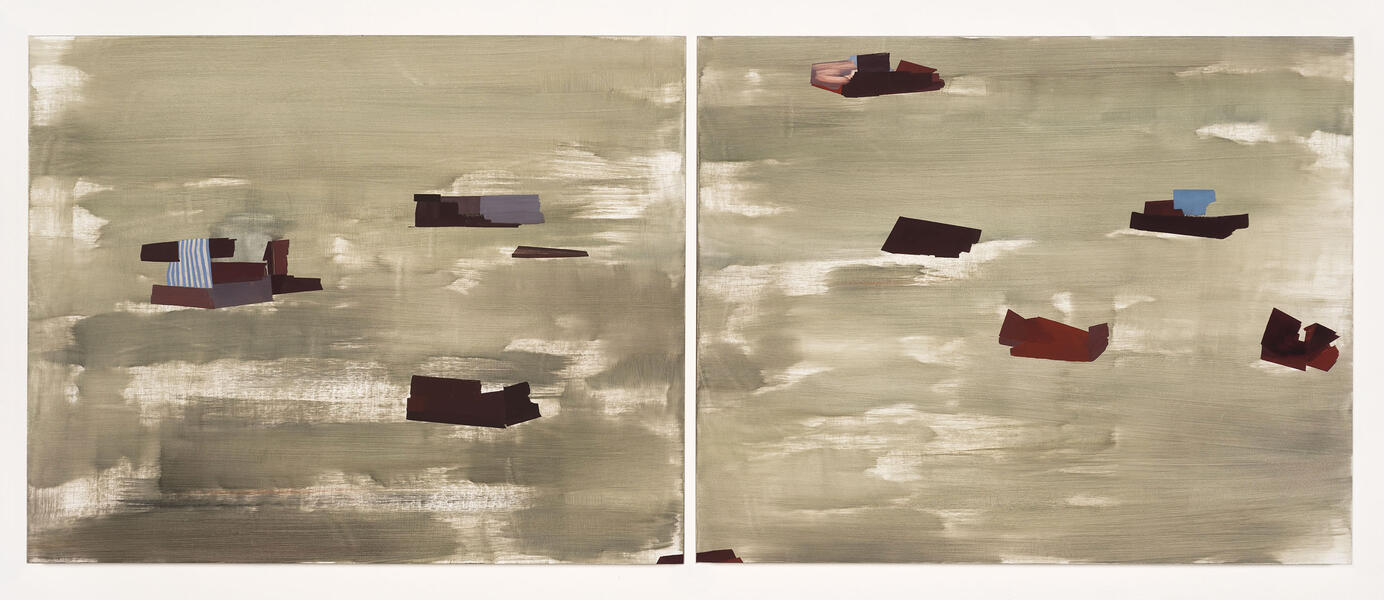 left unsaid2015 Oil on panel Horizontal diptych, Two panels 24" x 30" each
left unsaid2015 Oil on panel Horizontal diptych, Two panels 24" x 30" each -
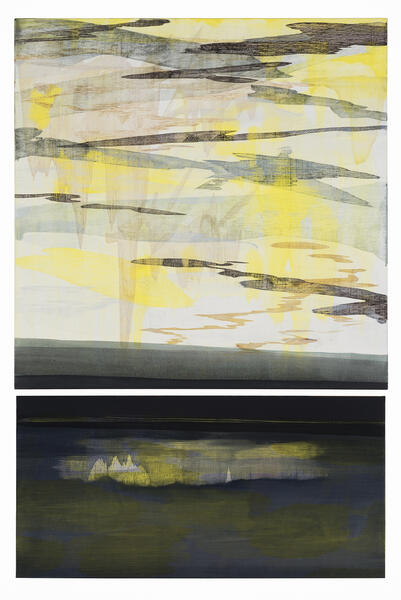 we roam and lie still2015 Oil on panel Vertical diptych, 24” x 24” and 12” x 24”
we roam and lie still2015 Oil on panel Vertical diptych, 24” x 24” and 12” x 24” -
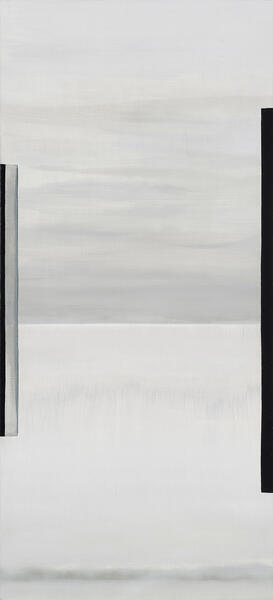 in awe of nothing2014 Oil on panel 22” x 10”
in awe of nothing2014 Oil on panel 22” x 10” -
 a potential turning point2014 Oil on panel 22” x 10”
a potential turning point2014 Oil on panel 22” x 10” -
 between here and there2014 Oil on panel 22” x 10”
between here and there2014 Oil on panel 22” x 10” -
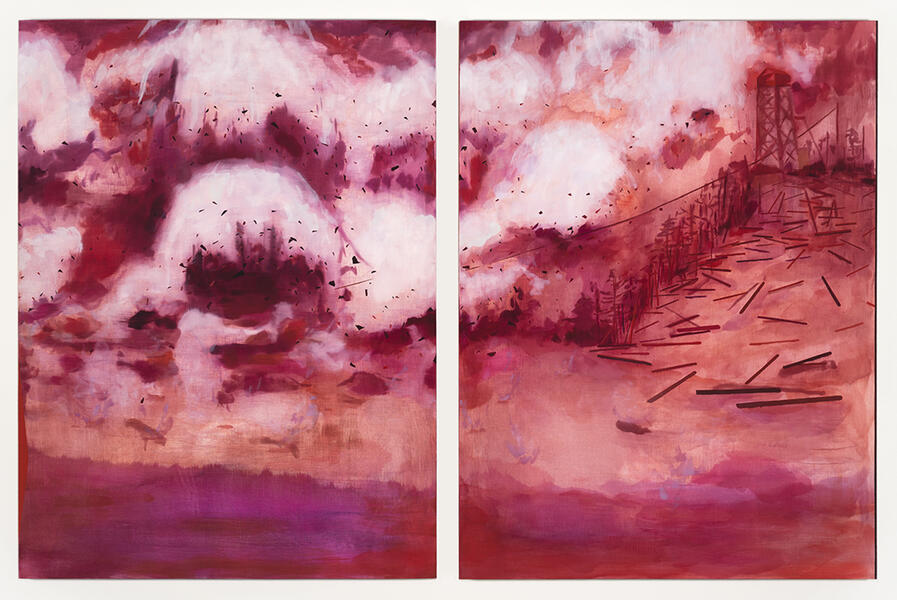 on both sides, there was a habit to edit and revise2015 Oil on panel Horizontal diptych, Two panels 40” x 30” each
on both sides, there was a habit to edit and revise2015 Oil on panel Horizontal diptych, Two panels 40” x 30” each
Landmark
As a body, these new paintings have a sense of conflated meaning. They imply the sublime and the history of landscape painting, while acknowledging the melancholic cycles of infrastructure and decay. Parallel to these ideas, I wanted to explore the more consumer oriented act of travel photography and tourism. In these conditions, what would be considered a landmark? l was interested in this term for the duality of its meaning as both a marker as well as a destination or place – it can indicate both where we are or where we want to go. It can be a point of reference in space but also an event or point in time, such as a turning point or a moment of discovery. In this context I could draw connections between the personal and the societal, the past and the present, the functional and the futile. With current political issues over water and energy resources, as well as what has felt like increasing severe weather and steadily rising environmental concerns, I wanted to incorporate the conflicting visual vocabulary that marks the land we live on and utilize. These are also our landmarks, they mark our occupation and use of the land, they mark a location, they will mark a moment in time - perhaps a turning point.
-
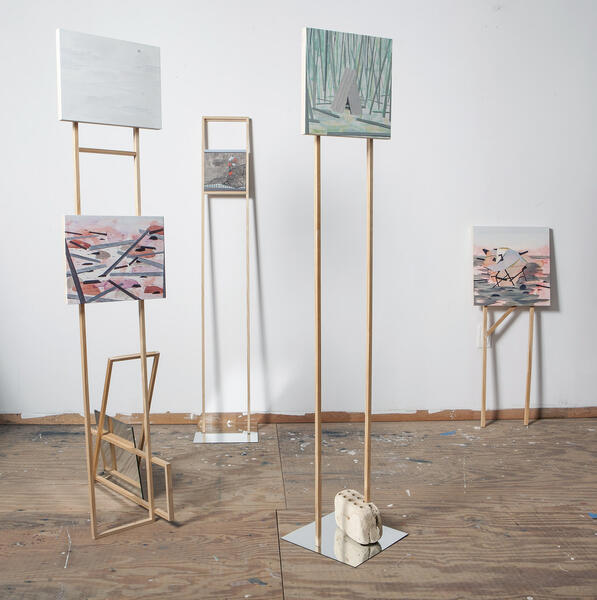 Studio view of multiple peices
Studio view of multiple peices -
 how we bury the past2014, oil on panel, 12 x 12 inches
how we bury the past2014, oil on panel, 12 x 12 inches -
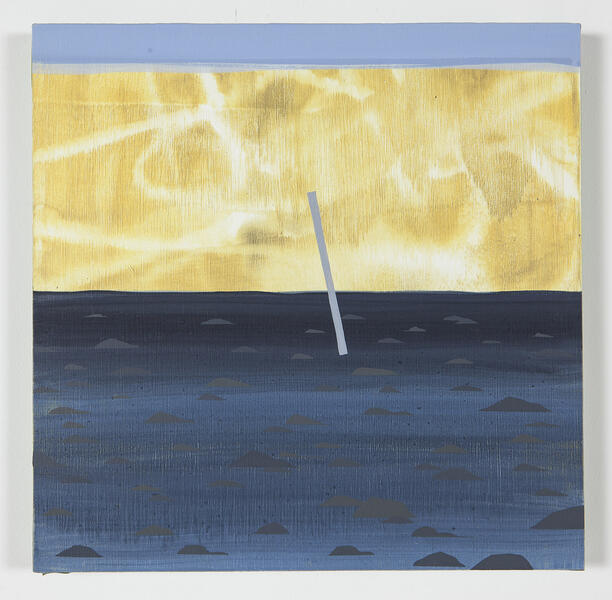 suspending hope, we dug up the future2014, oil on panel, 12 x 12 inches
suspending hope, we dug up the future2014, oil on panel, 12 x 12 inches -
 somewhere between lost and found2014, oil on panel, 18 x 18 inches
somewhere between lost and found2014, oil on panel, 18 x 18 inches -
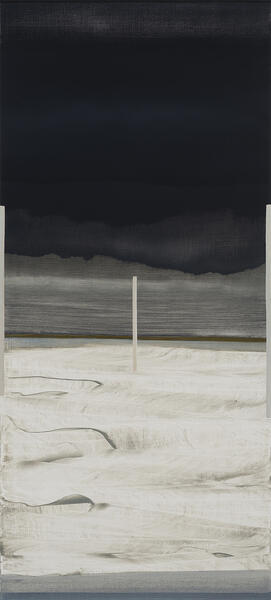 a means to measure change2014, oil on panels, 20 x 10 inches
a means to measure change2014, oil on panels, 20 x 10 inches -
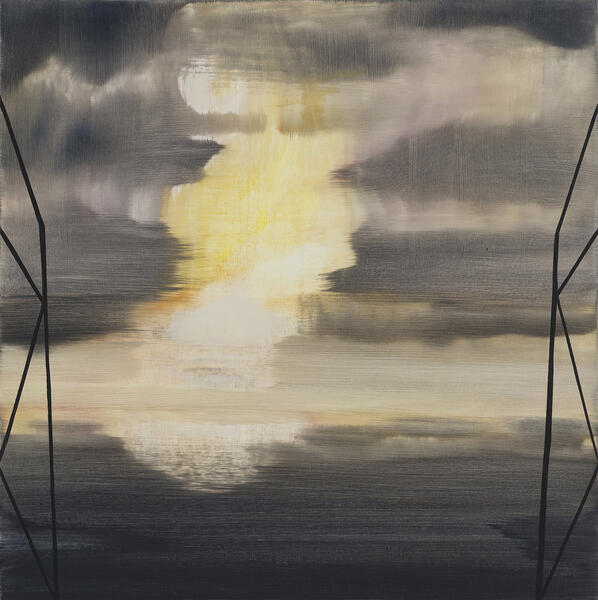 the near to far2014, oil on panel, 16 x 16 inches
the near to far2014, oil on panel, 16 x 16 inches -
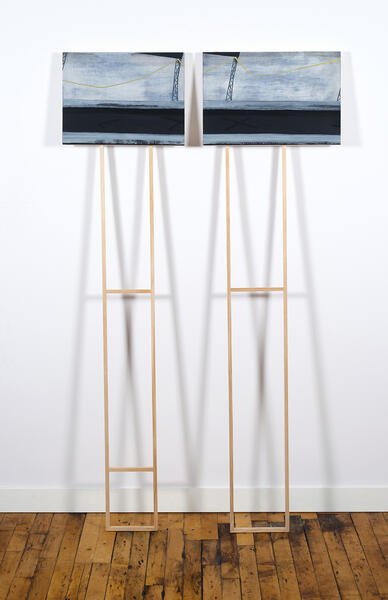 magnolialaurie03.jpg
magnolialaurie03.jpg -
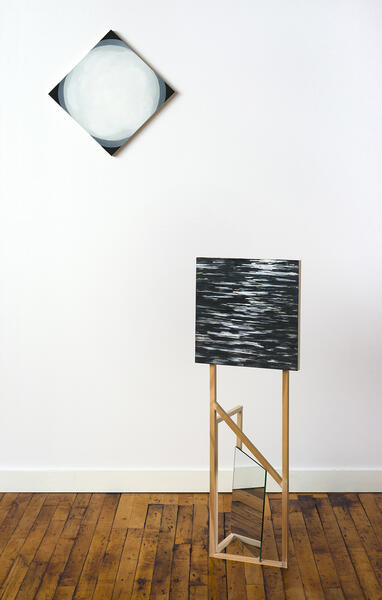 to the moon, from here (wall) & a reflecting return (structure)2014, oil on panels, 14 x 14 inches each
to the moon, from here (wall) & a reflecting return (structure)2014, oil on panels, 14 x 14 inches each -
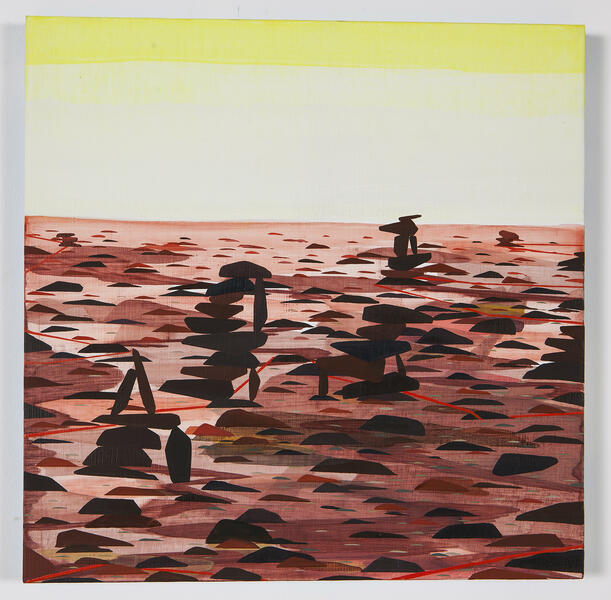 to lead us back again2014, oil on panel, 14 x 14 inches
to lead us back again2014, oil on panel, 14 x 14 inches -
 we could differ and still turn out better2014, oil on panel, 18 x 18 inches
we could differ and still turn out better2014, oil on panel, 18 x 18 inches
Markers
-
 to unmake history, againoil on panels, 12 x 12 & 9 x 12 inches, 2013
to unmake history, againoil on panels, 12 x 12 & 9 x 12 inches, 2013 -
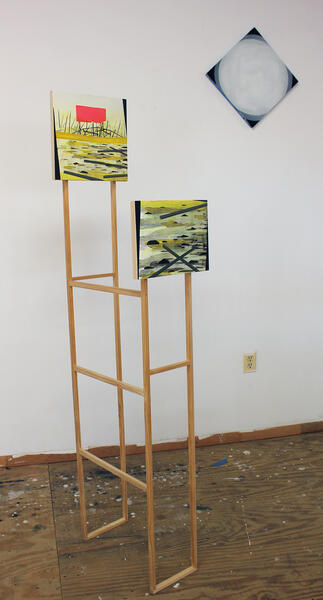 to unmake history, againoil on panels, 12 x 12 & 9 x 12 inches, 2013 on the wall: to the moon... oil on panel, 12 x 12 inches, 2013
to unmake history, againoil on panels, 12 x 12 & 9 x 12 inches, 2013 on the wall: to the moon... oil on panel, 12 x 12 inches, 2013 -
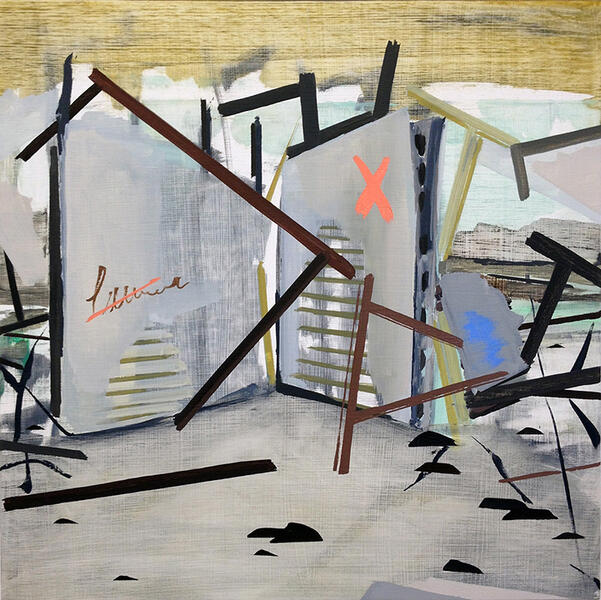 in praise of nothing but my favorite epithetoil on panel, 16 x 16 inches, 2013
in praise of nothing but my favorite epithetoil on panel, 16 x 16 inches, 2013 -
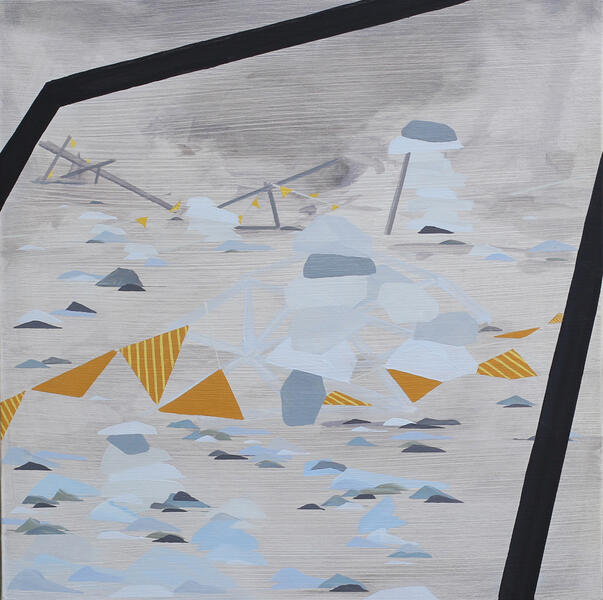 we have only built to settle stones, second tryoil on panel, 14 x 14 inches, 2012
we have only built to settle stones, second tryoil on panel, 14 x 14 inches, 2012 -
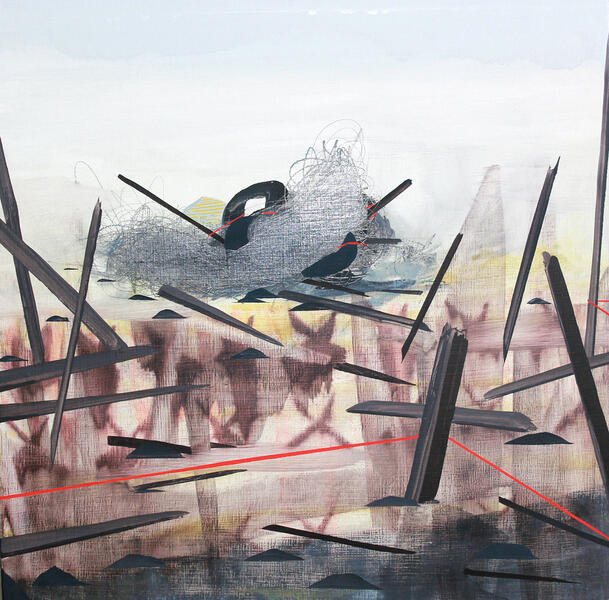 circumventing entropy, for a momentoil and graphite on panel, 18 x 18 inches, 2012
circumventing entropy, for a momentoil and graphite on panel, 18 x 18 inches, 2012 -
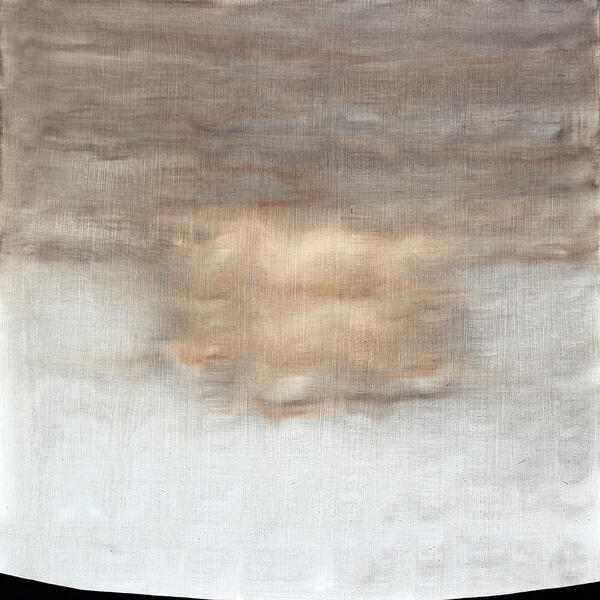 projectiles come to rest, we understand that better in hindsightoil on panel, 14 x 14 inches, 2012
projectiles come to rest, we understand that better in hindsightoil on panel, 14 x 14 inches, 2012 -
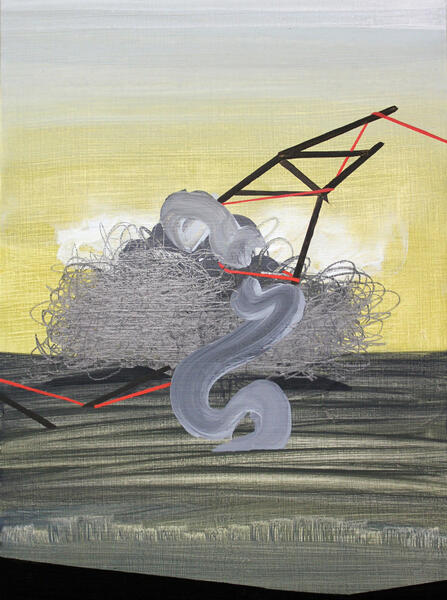 we’ve run amok, but we left a markoil and graphite on panel, 9 x 12 inches, 2012
we’ve run amok, but we left a markoil and graphite on panel, 9 x 12 inches, 2012 -
 I followed it back to what you didn't sayoil on panel, 12 x 16 inches, 2012
I followed it back to what you didn't sayoil on panel, 12 x 16 inches, 2012 -
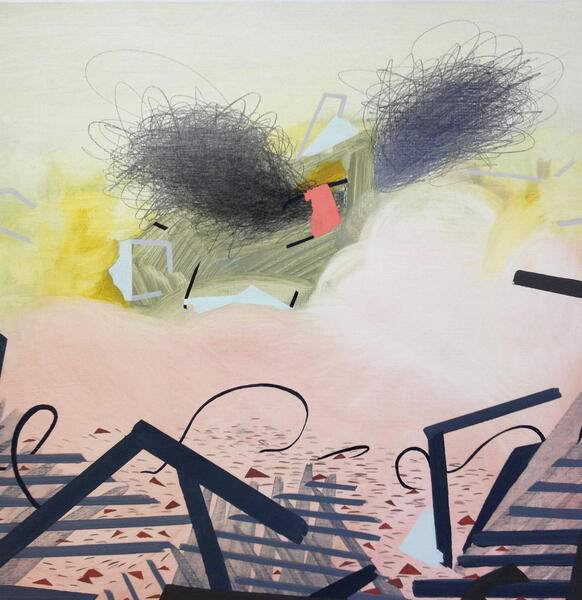 creating a tender ruin, we should ahve know bettergraphite and oil on panel, 18 x 18 inches, 2012
creating a tender ruin, we should ahve know bettergraphite and oil on panel, 18 x 18 inches, 2012 -
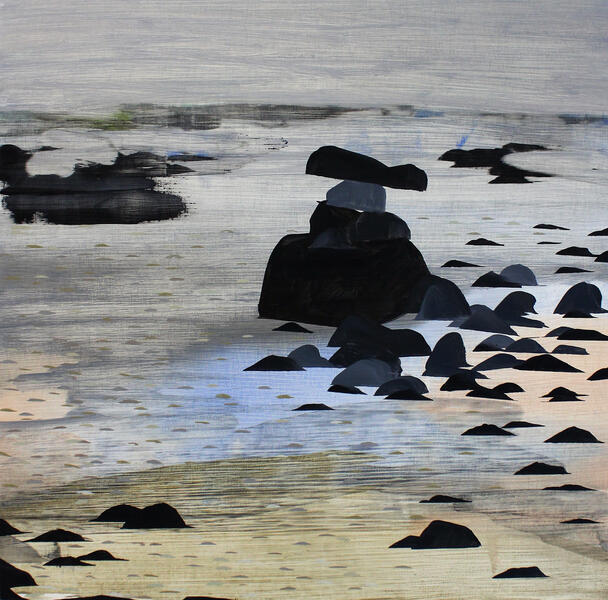 marker, indicating a quiet turn in our pathoil on panel, 14 x 14 inches
marker, indicating a quiet turn in our pathoil on panel, 14 x 14 inches
what could hold us together
Within the work I wanted to pose the question of what could hold us back from the brink of falling apart, as mounting political, social, and economic calamities seemed to perpetually threaten. I wanted What Could Hold Us Together to read both as a question to a hopeless answer, as well as a resilient statement of hope and assurance of what will persist and endure and maintain. The title of the exhibition comes from a line in Virginia Woolf’s To the Lighthouse. In 2012 I found myself rereading the novel along with Herman Melville’s Moby-Dick and John Steinbeck’s America and Americans. These narratives of precarious transition with wandering narrators informed the visual language and psychology of the environments in the paintings. Within the paintings I tried to balance domesticity with survival, the falsity of facade and the reality of barriers, and the hopeful with the hopeless.
-
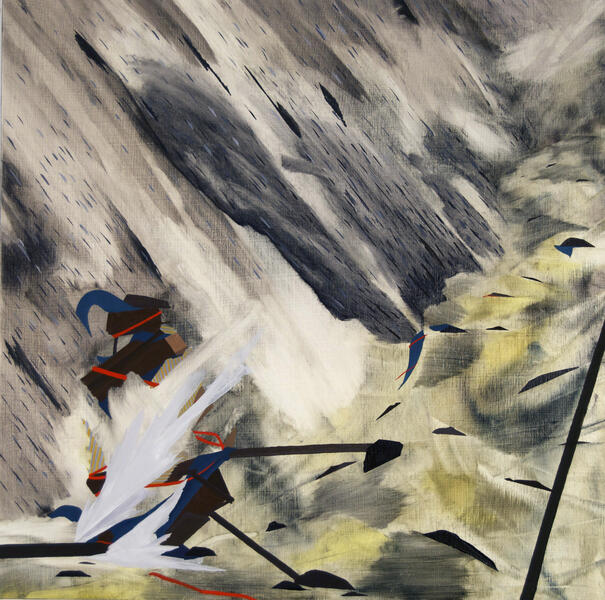 the urgency of the moment always missed the markoil on panel, 18 x 18 inches
the urgency of the moment always missed the markoil on panel, 18 x 18 inches -
 the aesthetic possibilities of indifference ,oil on panel, 18 x 18 inches
the aesthetic possibilities of indifference ,oil on panel, 18 x 18 inches -
 following a trail of vague marksoil on panel, 18 x 18 inches
following a trail of vague marksoil on panel, 18 x 18 inches -
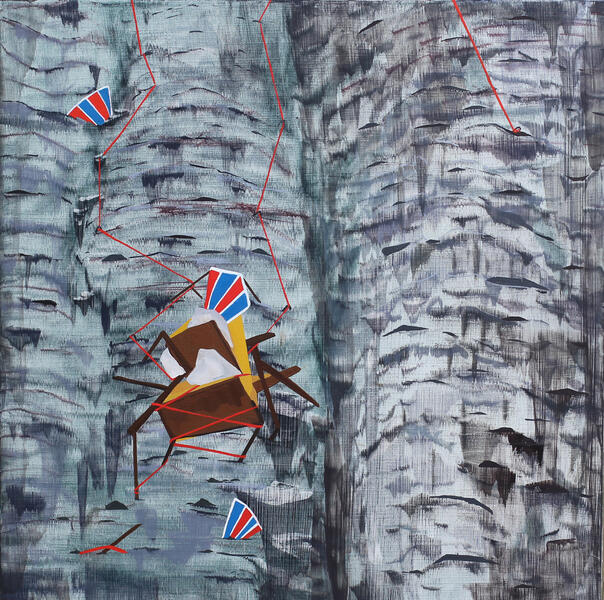 piling wreckage upon wreckage, collect and carryoil on panel, 18 x 18 inches
piling wreckage upon wreckage, collect and carryoil on panel, 18 x 18 inches -
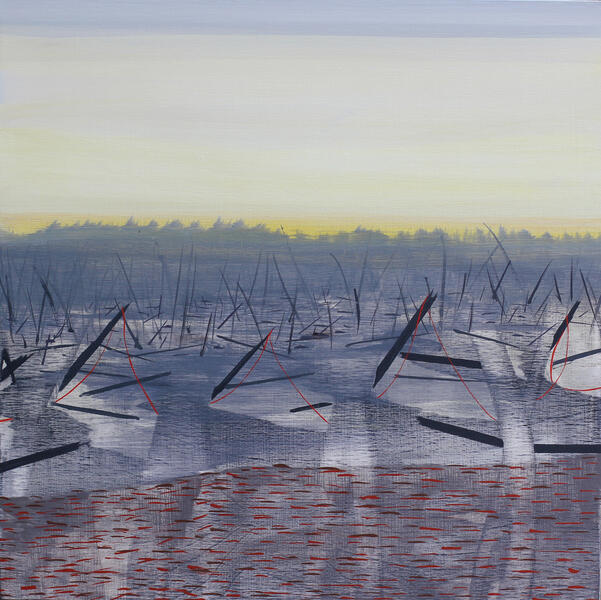 caught in a vast and benevolent lethargy of well wishing, we did nothingoil on panel, 18 x 18 inches
caught in a vast and benevolent lethargy of well wishing, we did nothingoil on panel, 18 x 18 inches -
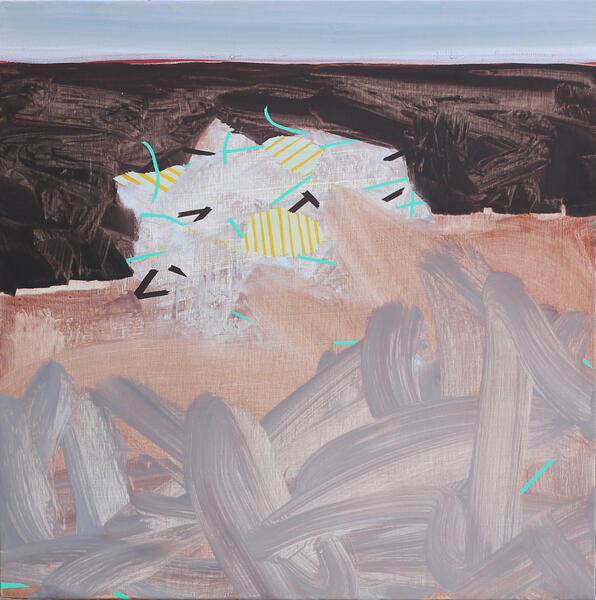 new lessons in geography, record breakingoil on panel, 14 x 14 inches
new lessons in geography, record breakingoil on panel, 14 x 14 inches -
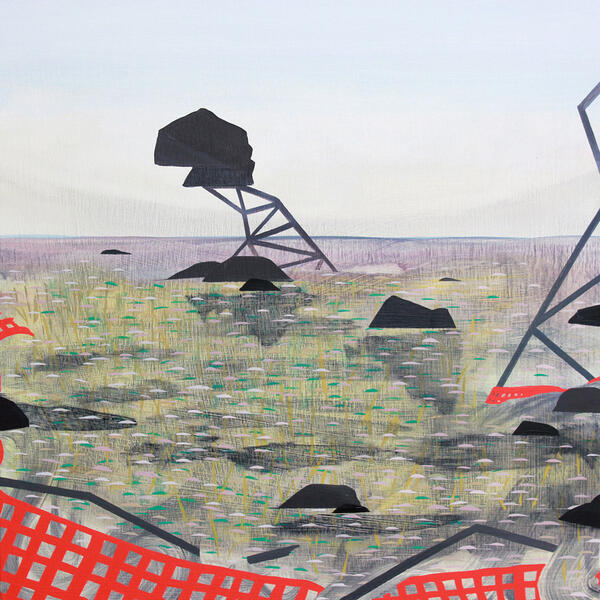 within a measure of unpredictabilityoil on panel, 18 x 18 inches
within a measure of unpredictabilityoil on panel, 18 x 18 inches -
 leaning, just a measure of acceleration, mass and timeoil and graphite on panel, 16 x 20 inches
leaning, just a measure of acceleration, mass and timeoil and graphite on panel, 16 x 20 inches -
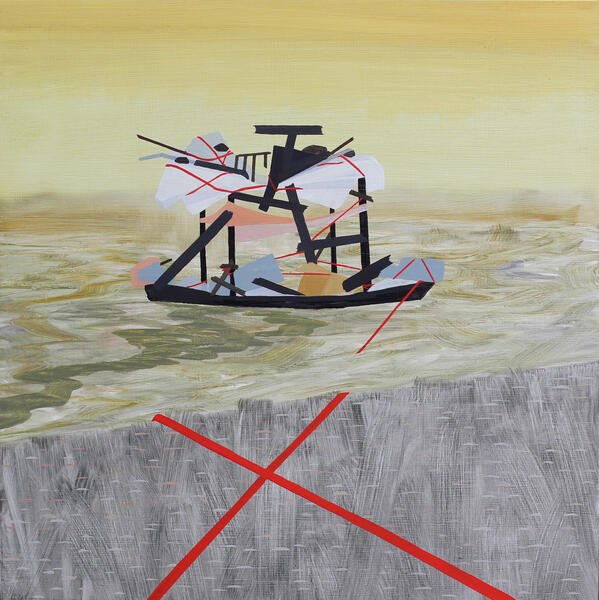 we can all adjust to inhabiting the accidentoil on panel, 18 x 18 inches
we can all adjust to inhabiting the accidentoil on panel, 18 x 18 inches -
 notions of comfort, knocked askewoil on panel, 9x12 inches
notions of comfort, knocked askewoil on panel, 9x12 inches

